Ep. 43: Mobile Suit Gundam: The Origin Vol. 1
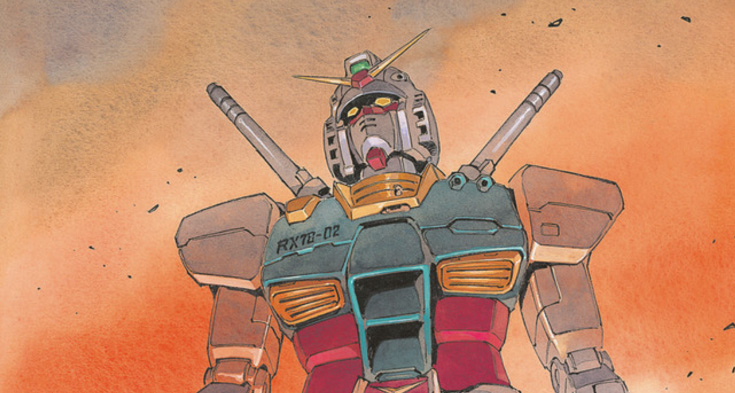
Get ready for a rollicking deep dive into the Gundam universe with Mobile Suit Gundam: The Origin. It’s often described as “Japan’s answer to Star Wars,” but as the Mangasplaining Gang learns this episode, it’s so much more, too! This episode also includes a bonus interview about Gundam featuring comics creator Emma Ríos, and don’t miss out on the HUGE show-notes below, either! What a week!
Powered by RedCircle
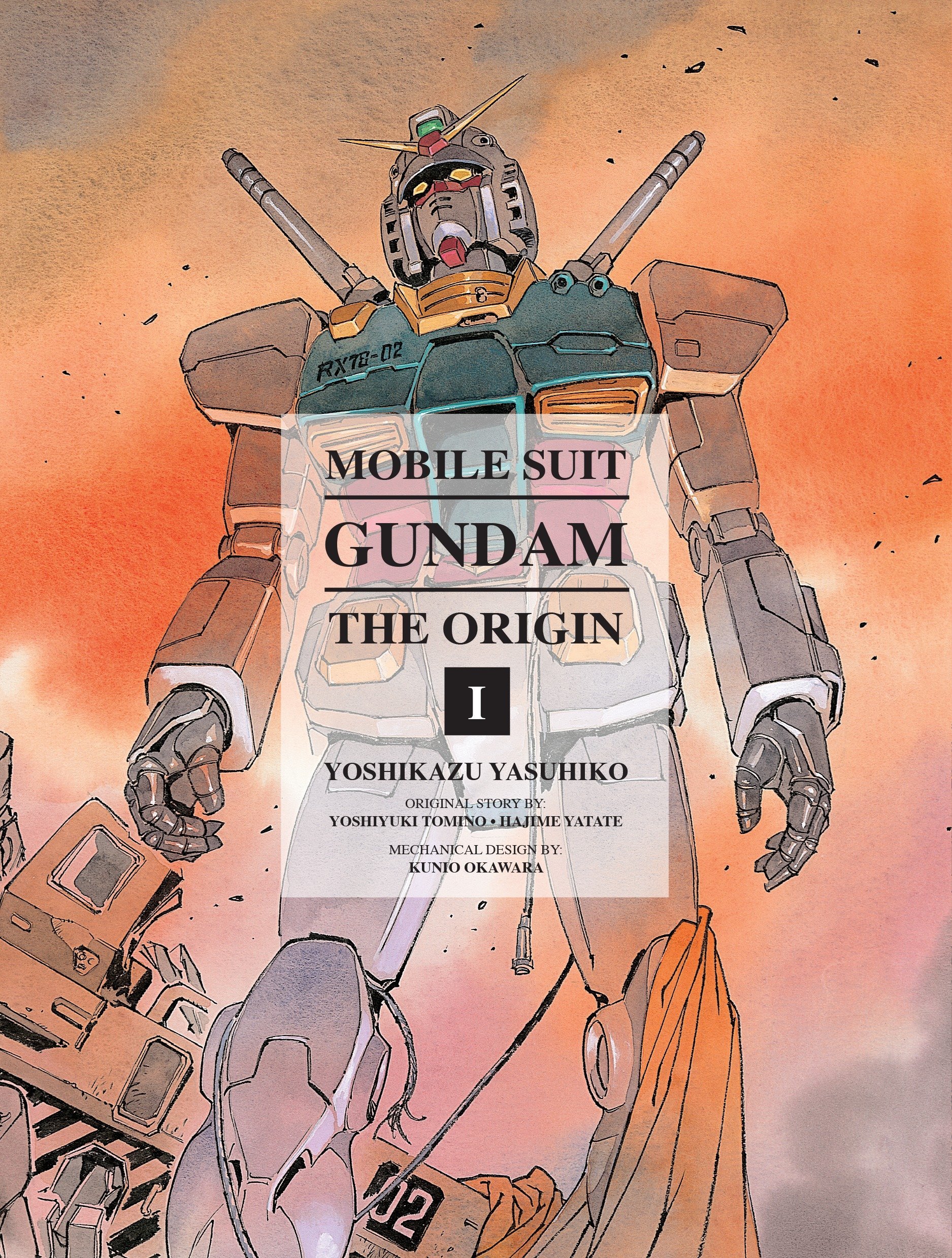
Mobile Suit Gundam: The Origin Volume 1
By Yoshikazu Yasuhiko
Original story by Yoshiyuki Tomino and Hajime Yatate
Mechanical Design by Kunio Okawara
Translated by Melissa Tanaka
Production by Grace Lu, Hiroko Mizuno, Nicole Docych, Daniela Yamada, and Risa Cho
Published by Kodansha/Vertical Inc. (Print Only)
Show notes by Christopher Butcher, Deb Aoki, and David Brothers. Audio editing by David Brothers.
Before We Get Started: Hi, Christopher here. I think David does a great job of explaining the nature of Gundam, and this manga in particular, and he unfolds that info outwards throughout the episode. As such, we’re not gonna jump in and ‘explain’ Gundam in these notes–there’s no point. It’s information that other people have written up and shared on the internet in so many other ways, better than I could do. Instead, we’ll maybe use all of these show notes to explain some of the culture around Gundam, and our interactions with it.
If you want the deeper dive, start with the cluster of Wikipedia entries that begin here: https://en.wikipedia.org/wiki/Gundam.
This week is also really special, because David jumped in and contributed a ton of notes, joining Deb and myself. Thanks, David!
Also really worth noting about reading this series: In addition to the hardcover edition published by Kodansha, and the much older VIZ edition, the current digital edition available through the Comic Walker service is available in Full Color! Wild. You can see a clear break between the colours that Yasuhiko-san created directly and the digital colours, but it’s pretty cool. The first three chapters are available to read for free at Comic Walker.
It’s a great way to check out the series and see if it’s for you!
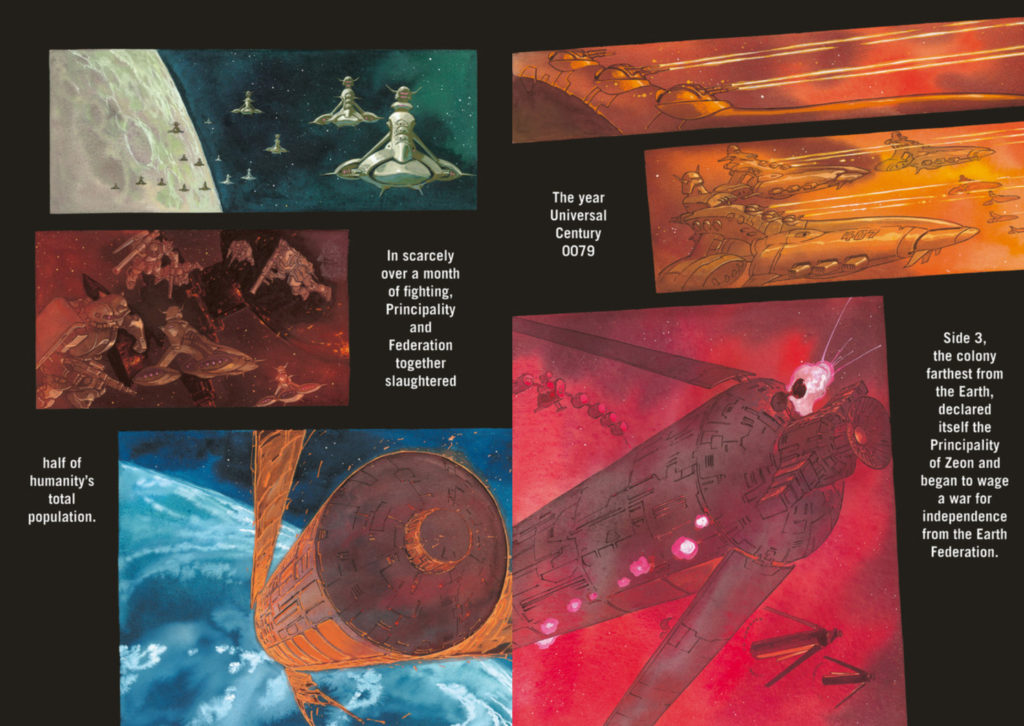
00:00 David and Christopher spend the first few minutes explaining, basically, that Gundam is a large, complex, multi-generational franchise in Japan. Think of it like Star Wars, I guess?
Actually I wanna dig into the Star Wars comparison (Deb also makes it later). It’s a connection that’s made a lot when explaining Gundam to Westerners. It’s a really interesting comparison, because after Return of the Jedi, Star Wars as a franchise got a few short animated series, and mostly disappeared into the ‘expanded universe’ of novels, comic books, and collector-oriented (as opposed to mass-market) figures and statues. Then the prequel movies were released to theaters, it became mainstream again. It got a few more animated series, and then a few years after the Happy Meals™ and whatnot, went back to being geared for collectors and hardcore fans only through less mass-market media. With Disney’s acquisition of Lucasfilm, they shifted to the current strategy of mass-market Star Wars stuff happening all the time: a new movie every single year, animated and live-action TV series, special projects, mass market toys, all of that. Granted COVID and poor reception to the new trilogy sort of put the brakes on that a little, but the plan is for there to be new, mass-market Star Wars products forever, from about 2015 with The Force Awakens, onwards.
Gundam is a bit like that, except when they redid the original 1979 television series as a series of three movie-length compilations from 1981-1983. Then they just… kept making more new animated TV series set in the Gundam universe, along with new movies, new manga, new spin-offs, and then to go along with all of that, new toys! So many new toys, most of it consisting of “Gunpla” (Gunpla is a portmanteau of “Gundam plastic model”) or plastic model kits that the users assemble and paint. But Gundam merchandising doesn’t stop at plastic models — it includes action figures, dolls, apparel, accessories, theme restaurants, and those ‘life-sized’ Gundam statues in Tokyo… whatever you like. Gundam has literally never stopped being a part of the Japanese pop culture universe, with no real breaks in any way since 1983.
Gundam might just be Star Wars done right.
(Please don’t come at me, bro.)
[Deb:] Nikkei Asia has a great in-depth look at the Gunpla dream machine — how it has racked up 500 million kits sold over 40 years, and shows no sign of stopping.
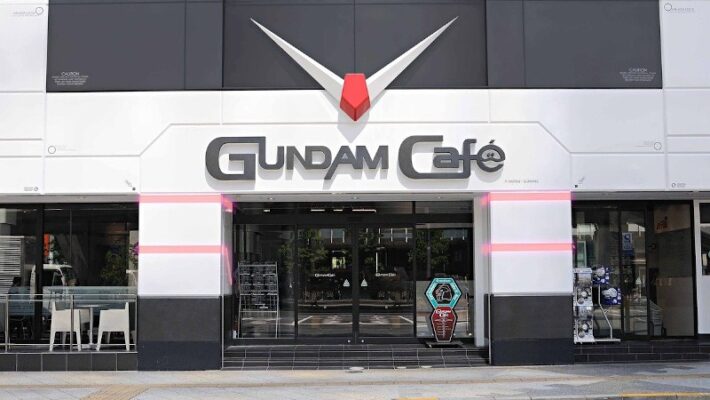
1:45 Yoshikazu Yasuhiko, aka YAZ. He’s mentioned more than a few times that way. 🙂
2:25 So yes, as we have alluded to, David has taken to building and painting Gundam model kits, and then showing those builds (and the learning curve that comes with them) on his Instagram. Sorry fans, his Insta is private, but he did include a few images he wanted to share here with everyone.
[David:] Here is the robot I built while editing this episode, because it turns out they’re two tasks that mesh well together when multitasking! This is the Xi Gundam from the movie Mobile Suit Gundam Hathaway, and you have to say it “ksi” for reasons I don’t remember.
[David:] And here is the robot disassembled while I get ready to repaint all the blue parts a different color (not sure yet, purple?):
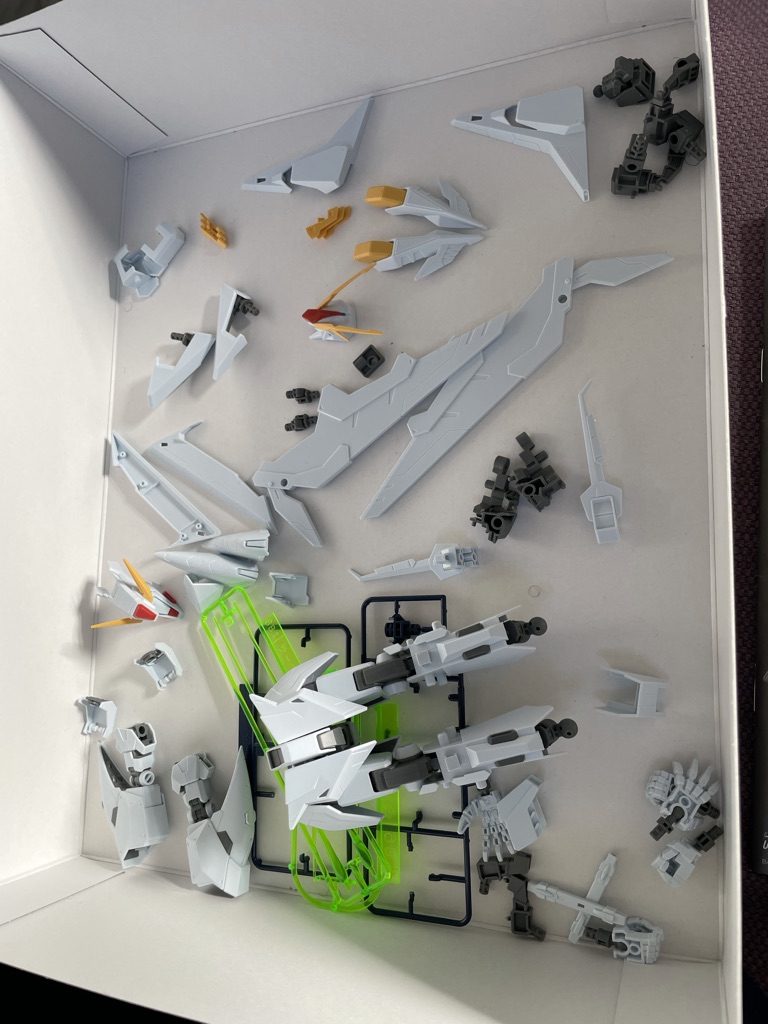
4:00 Yeah, I gotta learn to stop dropping random stuff into these episodes that I will then need to write an explanation of in the show notes.
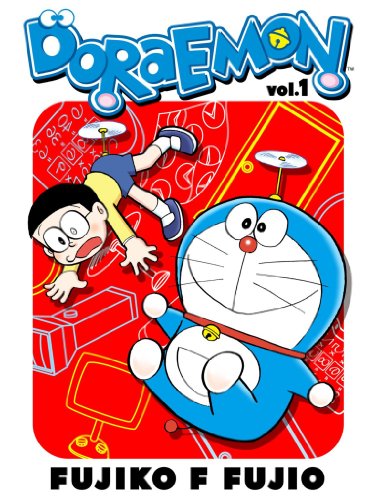
Doraemon is a manga series that debuted in 1970 by Fujiko Fujio, who was actually two dudes working together under a single pen-name, although both later went on to create separate works under very similar sounding pen names – Motoo Abiko as Fujiko Fujio Ⓐ and Hiroshi Fujimoto as Fujiko F. Fujio.
Doraemon is the name of an earless blue cat robot who comes back from the future to befriend a nerdy little boy named Nobita. Since Doraemon hasn’t really been imported to N. America, its popularity throughout Asia can be difficult to explain to Westerners… it might be on par with Bugs Bunny I guess? Doraemon is at least nominally owned by the people/family who made him, and not the intellectual property of a work-for-hire corporation.
[Deb:] Or maybe another comparison might be Asterix, a beloved kids’ comics series in Europe that’s nearly unknown to N. American audiences.
[Chris:] The 45-volume manga series has spawned literally thousands of animated television episodes, 40 feature-length movies (released annually forever), and countless merchandise and spokes-character tie-ins that continue to this day. Doraemon is the most omnipresent franchise in Japan that has barely made a dent in North America.
[Deb:] Though not for lack of (admittedly half-hearted) efforts to introduce Doraemon to English-speaking audiences. Friend of Mangasplaining Matt Alt and Hiroko Yoda translated/localized 200 volumes of Doraemon manga, however it’s only available through Kindle. Cover above.
[Chris:] 200 volumes! Wild. Worth noting that this manga release roughly coincided with the Doraemon anime being added to Disney’s XD Channel a few years back, though heavily ‘adapted’ for western audiences to remove as many Japanese references as possible, and to edit out any potentially offensive scenes for the 40-year-old animated series. It was… poorly received by nerds, but my sense is it did fine amongst its intended audiences of young people. You can watch the whole first episode reasonably illegally over on YouTube.
MEANWHILE, Doraemon’s conquest of Japan continues unabated. For example, here’s the grown-up cast of Doraemon in a series of Japanese Toyota commercials. The role of Doraemon is played here by French actor Jean Reno.
MEANWHILE AGAIN, here’s a different cast of grown-up Doraemon characters in a series of Japanese Softbank phone company advertisements. Here, the role of Doraemon is played by Bruce Willis.
Yeah, Doraemon is a whole thing.
Wait ‘til you learn about Anpanman. (Anpanman movies are now airing on Tubi)
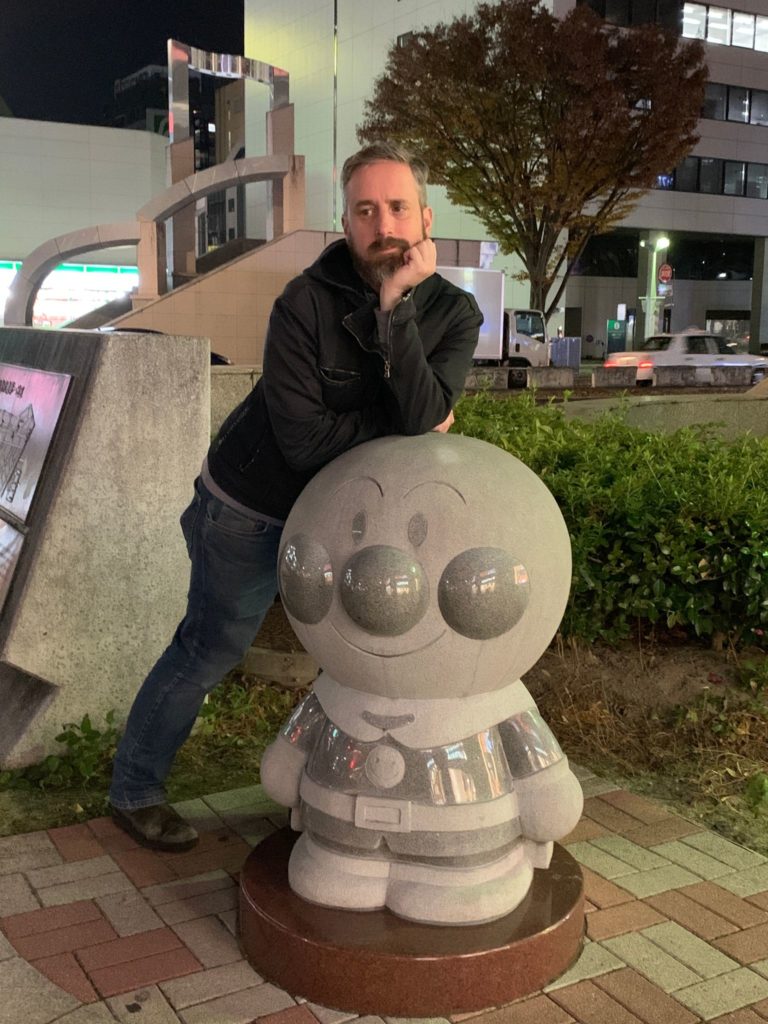
4:40 While this anecdote did happen in an anime-themed bar located on the second floor of a tiny old building in the Golden Gai area of Kabukicho in Shinjuku, Tokyo… this kind of thing actually happened more than once. Explaining that the most popular Gundam series in North America was, for a very long time, Gundam Wing, really makes Japanese otaku sad. Not even angry, just bummed right the fuck out. It’s kind of funny? But also sad too. I think the easier availability of Gundam on DVD and now streaming has helped change the dialogue there, but honestly, Gundam Wing getting broadcast on TV kind of changed everything.
Speaking of which:
Gundam Wing is a 1995 spin-off anime from the main Gundam series, taking place in a different timeline than the book we read this episode. It’s Gundam through-and-through, it’s about a war between Earth and its colonies and revenge plots and giant robots — compelling stuff! But what makes people hate it is that it stars five very pretty young men as the pilots, and they’re all moody and disaffected. It’s a bit like boy-band Gundam in a lot of ways, and that is not the sort of peanut butter Gundam-otaku want in their military conflict chocolate, if you follow my metaphor.
If you want to give it a try, it’s streaming on Funimation.
5:51 So Japan has built several ‘life size’ giant Gundam robots over the years. At first, the head of a Gundam was built, and it proved so popular that they built the whole darn thing, at 1:1 scale so it’s 18m tall. It’s the very first-ish Gundam (as found in Gundam: The Origin), the RX-78-2, and it debuted in 2009 on the island of Odaiba in Tokyo Bay.
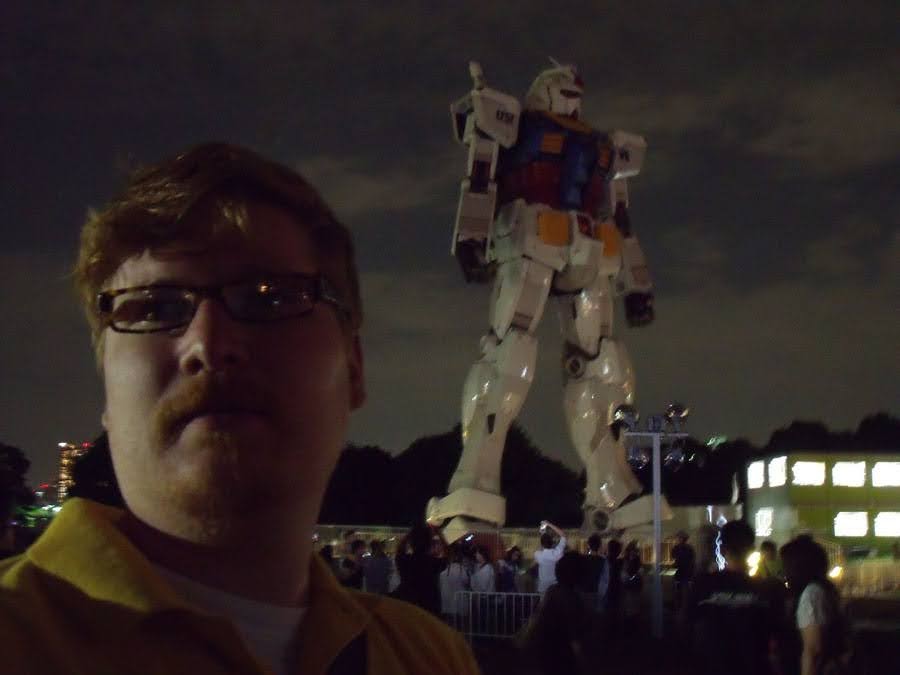
They took it down and then moved it to Shizuoka in 2010, and then after it was damaged by a typhoon, it was disassembled, displayed in parts, and then they rebuilt it better than ever, and it came back to Odaiba in 2012.
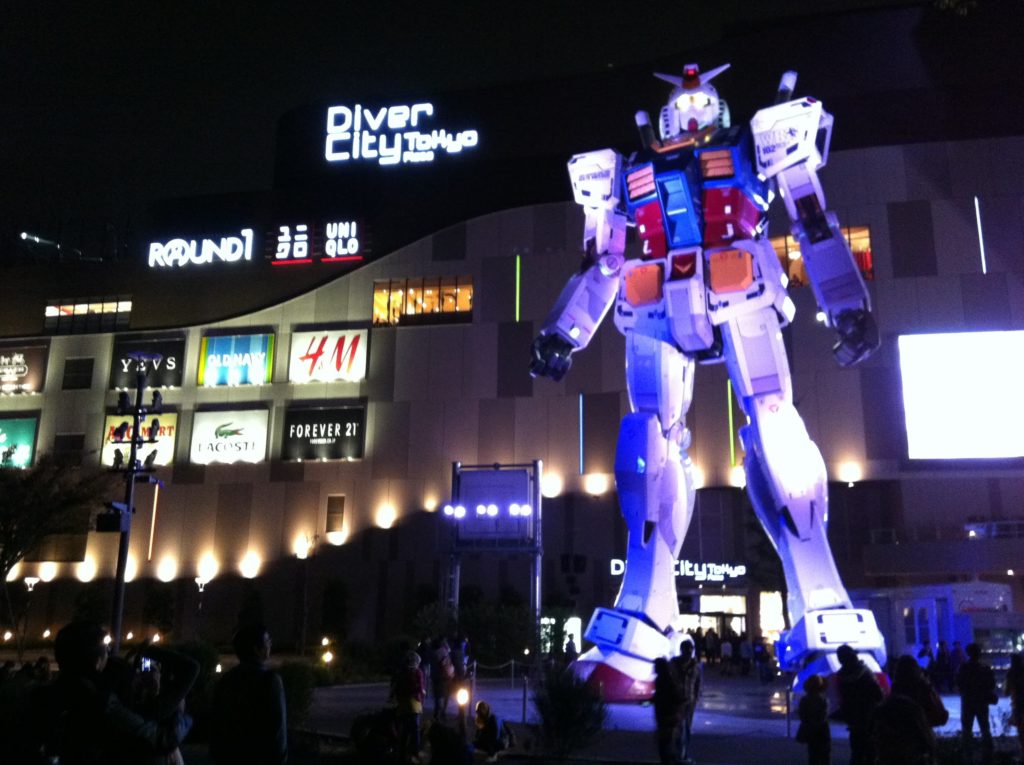
Then after many years, they took it down forever (sad day). Here it is from its last year.
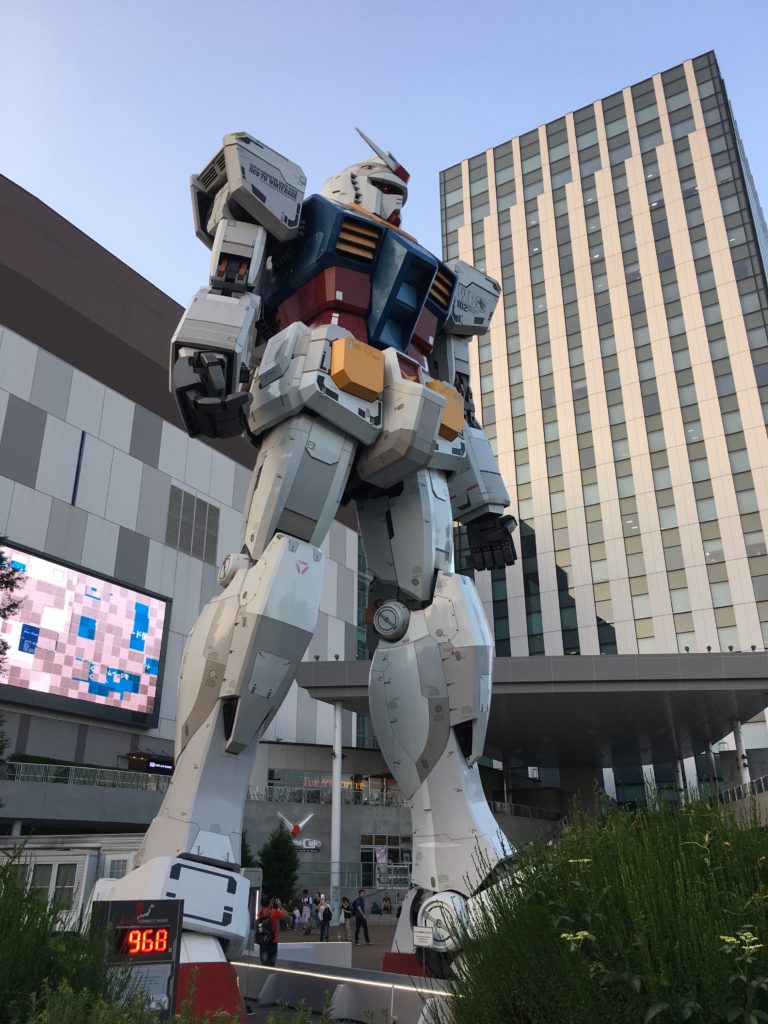
But then later that year in 2017, they they replaced it with a modern RX-0 Unicorn Gundam, from a popular-everywhere-in-the-world-except-America anime series Unicorn Gundam. It’s impressive and moves a bit more than the previous Gundam! It’s bigger too, 19m tall!
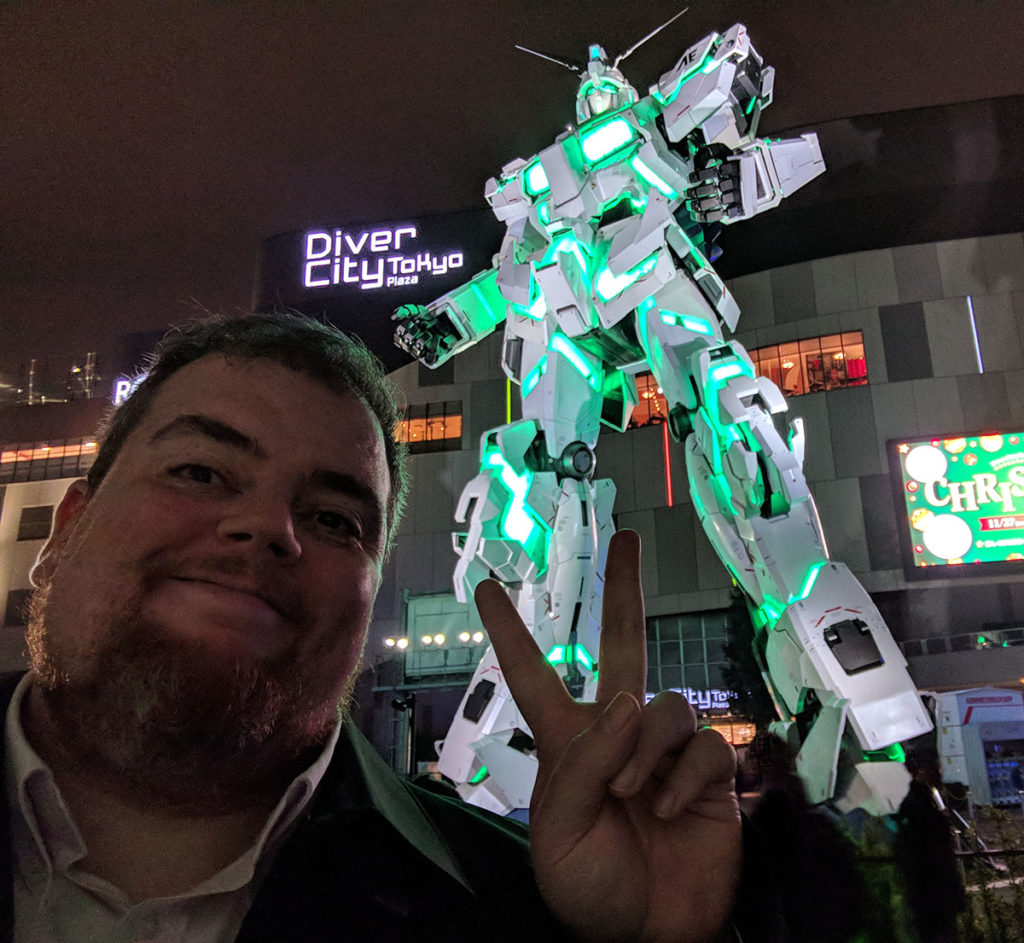
But there’s also a moving, ‘walking’ Gundam down in Yokohama! I haven’t been to it yet for some dumb reason. So instead of a photo of me with the Gundam, here is the official website for Gundam Factory Yokohama. https://gundam-factory.net/en/.
[Deb:] And the life-sized Gundam statues just keep happening. This year, a version of RX-93FF ν (Nu) Gundam was unveiled in Fukuoka, Japan.
6:41 David was kind enough to share his Gunpla expertise, and describe the different ‘grades’ (i.e.: Difficulty levels) of Gundam model kits.
Entry Grade: You don’t even need to cut these out of the plastic. In fact, this person assembled an entire kit without opening the packaging. https://www.youtube.com/watch?v=gRqzQS_qu0E
High Grade: Better than Entry Grade, these are the more common kits you’ll find around. While they were originally pretty basic, these kits are pretty astounding these days, both in terms of complexity and sheer cool factor when it comes to design. They’re in 1/144 scale, a bit taller than, say, a GI Joe.
Real Grade: Another 1/144 scale line, these kits are not just more complex, but designed as if the robots were created today. That usually means a lot of fiddly decals and whatnot, but these bridge the gap between the more beginner-friendly High and Entry Grade kits and the more complex Master and Perfect Grades.
Master Grade: The first kit David built was a Master Grade, because he ain’t no punk! Sorry. These are 1/100 scale, like a big GI Joe, and tend to have more complex builds and amazing little details.
Perfect Grade: These are huge, bro. Like… 1/60 scale. If you’ve built one of these, not only do you love Gundam, but you probably have a nice garage to build model kits in.
16:47 As brought up very early in the history of the podcast, Force Five was Chip’s first (and almost only) interaction with anime as a young person. A 130-episode animated series that ran from 1980-1985 in select television markets, Force Five was actually an adaptation of five different giant robot series’ from the 1970s mashed together into a rotating cast of giant robot stories, heavily edited and rewritten for American audiences. This included Gaiking, Danguard Ace, Getter Robo G, Grendizer, and Starzinger. It was produced due to the popularity of the Shogun Warriors series of robot toys, which were themselves picked and chosen from a variety of disparate giant robot productions in Japan.
It’s interesting, because the animated television series Transformers was based on the merging of a number of different Japanese toy lines into one cohesive toy line, around which an original animation was written and created. Similarly, the TV series Robotech was a mash-up of three separate 1980s Japanese animated series: Macross, Southern Cross, and Genesis Climber Mospaeda. Same thing happened with Voltron and a few other similar series too. This was a popular way to adapt Japanese content for N. American audiences back in the day, and as I can tell, this never happened with Gundam.
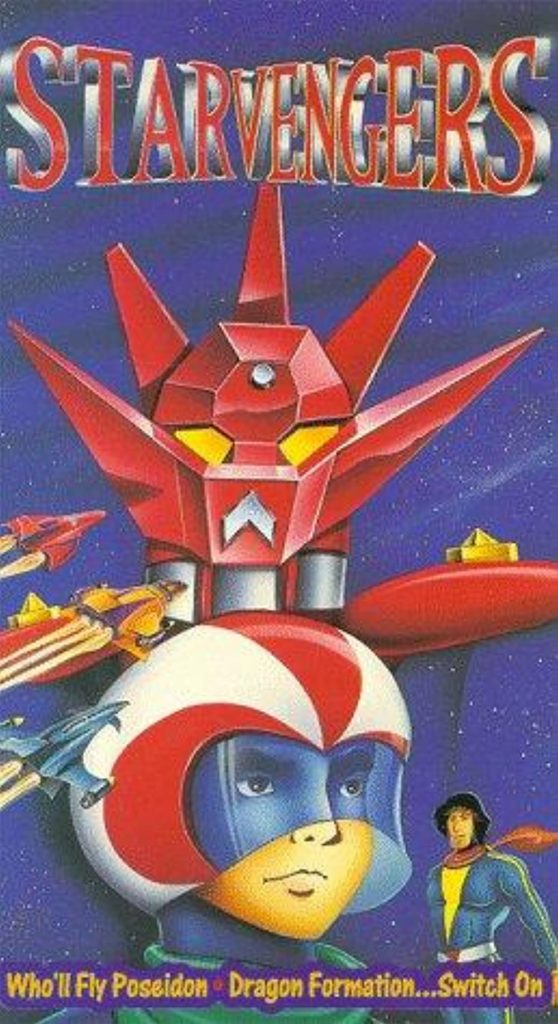
18:30 Chip says the colour pages are good! They really are too.
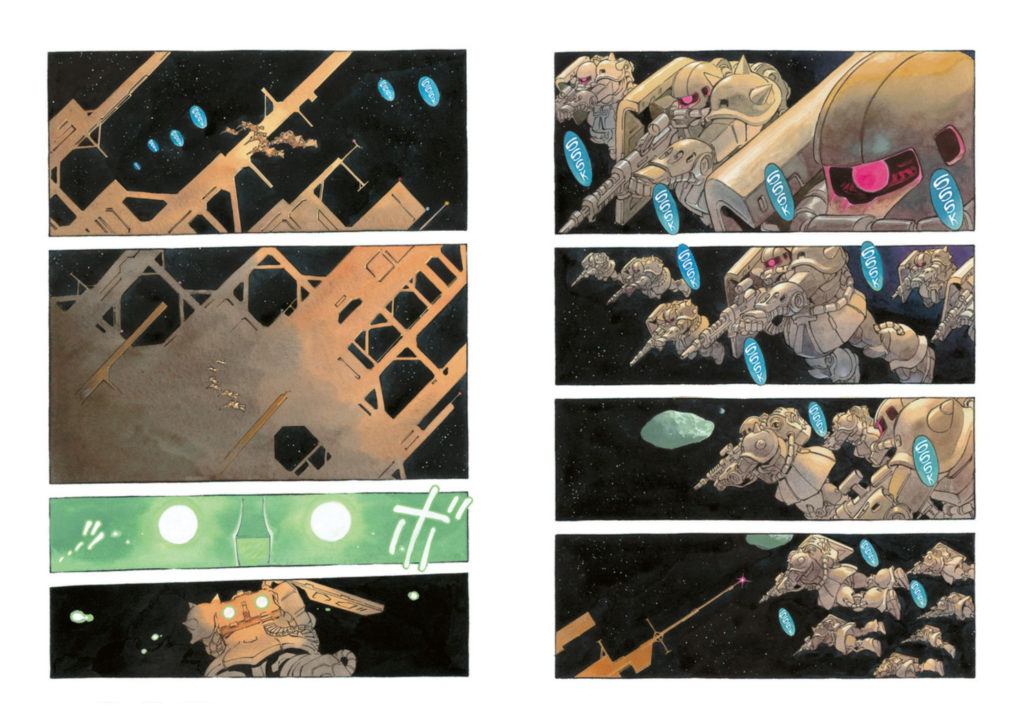
21:44 So during the manga boom of the late 1990s, thanks almost entirely to Tokyopop’s publishing of Sailor Moon, lots of companies entered the manga market (or tried to significantly upgrade and increase their output). One of the newcomers was ComicsOne, a publisher and distributor based out of Fremont, California. Their publishing strategy was completely insane in the best way, just publishing a little bit of everything that they could get their hands on. They published the fishing comic Bass Master Ranmaru! They published Junji Ito horror comics like Tomie! They published one of the first bona-fide cooking comics, Iron Wok Jan! They published weeb titles, mainstream titles, softcore porn titles, kids titles, as well as Hong Kong “kung-fu” manhua titles like Crouching Tiger, Hidden Dragon! They also did truly crazy shit like selling eBook manga in 1999, wellll before tablets, ereaders, etc., during the earliest days of Adobe eBook reader. It’s wild. Including titles that didn’t get a print release! Including boys love manga before anyone else was doing BL titles!
Anyway, ComicsOne published five volumes of manga across two series by Yoshikazu Yasuhiko, author of Gundam: The Origin! The first, Joan, is a 3-volume historical fiction manga about a young woman who undergoes very similar trials to the historical figure Joan of Arc, with the two young women’s lives contrasted. It’s a full-colour, painted manga, and it’s really quite lovely (and sooooo out of print/hard to find!). In the same style, Yasuhiko also created a two-volume manga simply titled Jesus, about the life of Jesus.
You can see a little bit about where the company ended up before it went into receivership, was purchased by the printer they were using to publish books, who renamed the company Dr. Master, and then themselves went bankrupt during the manga bust. It’s a neat time capsule. https://web.archive.org/web/20040901143401/http://www.comicsone.com/
These books are long, long out of print, and while they were very much not in demand during their initial release, they have become insanely expensive in certain corners of the market. You can, WEIRDLY, get some of them through real world lending libraries that were super hot on digital editions in the early 2000s! Check it out, a bunch of early digital editions of ComicsOne titles at a California library!
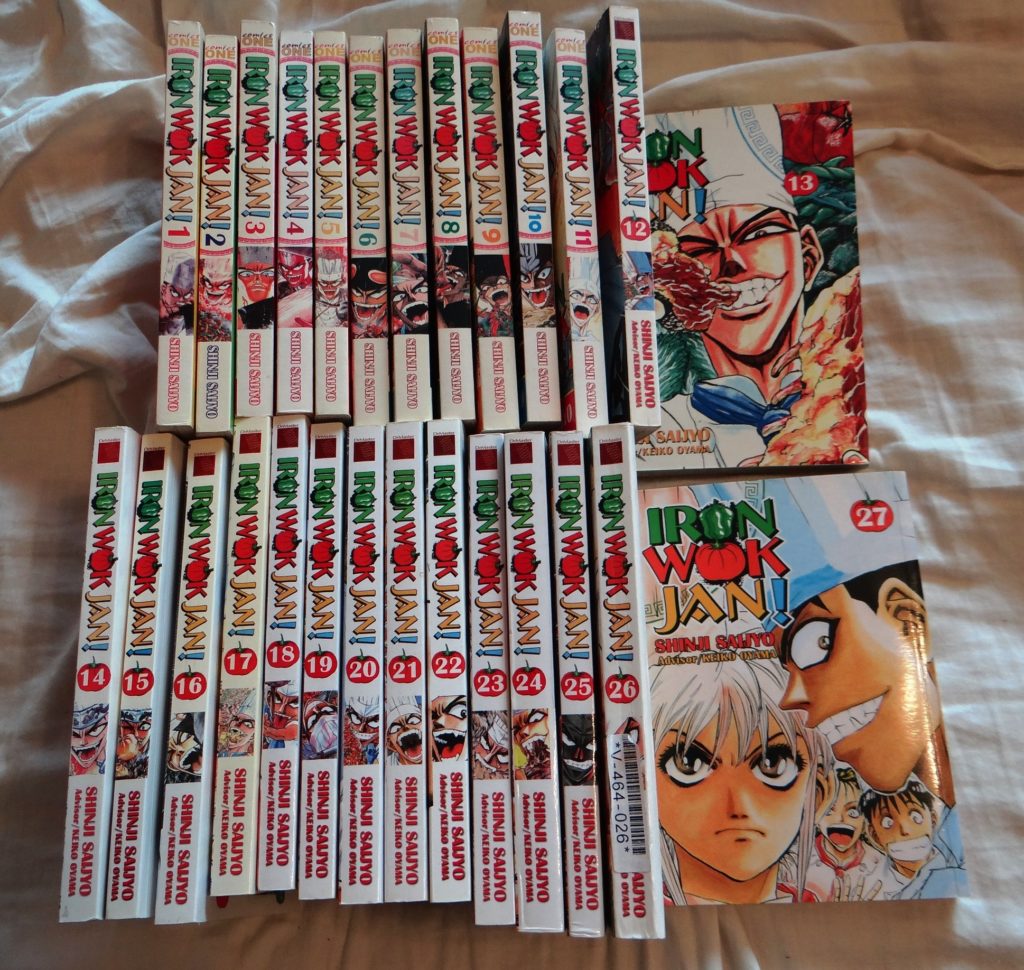
23:45 That movie that David is talking about? Why it’s none other than Mobile Suit Gundam Hathaway,
[David:] The last line of this trailer is a good example of how Netflix can half-ass translation, it’s more properly “The grim reaper won’t come when you’re ready for him, Hathaway,” which is way cooler.
25:45: Worth noting, fans call the original television anime of Gundam released in 1979 “First Gundam.” That’s a phrase that creeps in around the edges of this episode, and in these show-notes.
26:09 It’s true, Taschen and Marvel are collaborating to create real darn big, oversized collections of classic Marvel comics. The first book? Weighing in at 28cm x 40cm, 700 pages and 5 kilograms, it’s Marvel Comics Library. Spider-Man. Vol. 1. 1962-1964. Amazing Fantasy #15 and Amazing Spider-Man #1-20 in one massive book, with every page, advertisement, etc., treating them as archive editions. Photographed from the original book. It’s wild.
I haven’t seen this in person yet, but if it’s as good in person as it looks in these photos, this would be the only reprint of this material that I might ever want. Wild.
27:05 Gundam The Origin was first released by VIZ, in North American comic book size, from 2002-2004. They were released as very thick ‘issues’, sort of a half-measure between comic book serialization and straight-to-graphic-novel, which is the current mode of almost all manga. The VIZ editions seemed to reprint 3-4 chapters of the manga contained in this volume, so that the first three VIZ editions would add up to one volume of the Vertical edition.
28:24 As Deb mentions, page 267 is a very cramped page, in a cramped spread, in a kind of a cramped sequence. As David mentions though, it all looks pretty good… as long as your eyes are up to the challenge of the small type. 🙂
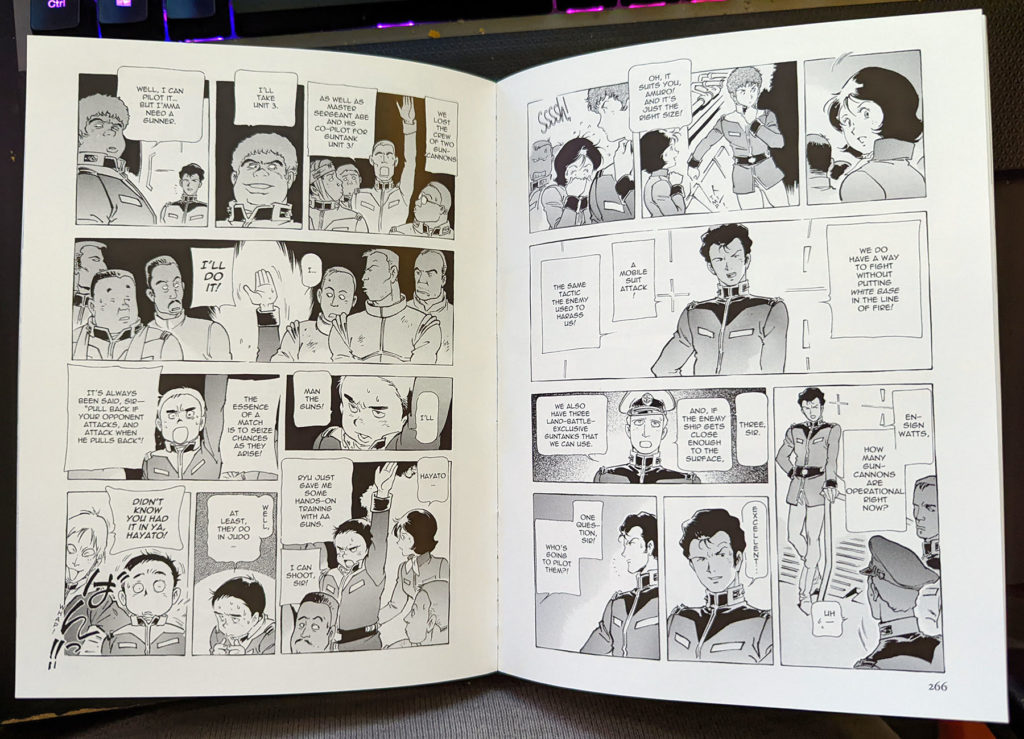
28:50 OMG, haha. Nice one, David.
29:55 So as David mentions, this huge kick that Char’s Zaku gives to Amuro’s Gundam unit is a big iconic moment in the series that has been revisited multiple times. Here in Chapter 5, page 223, the kick is rendered in a somewhat understated way. Contemporary artists would make it a splash, if not a double page splash. Still powerful and beautiful, but definitely understated.
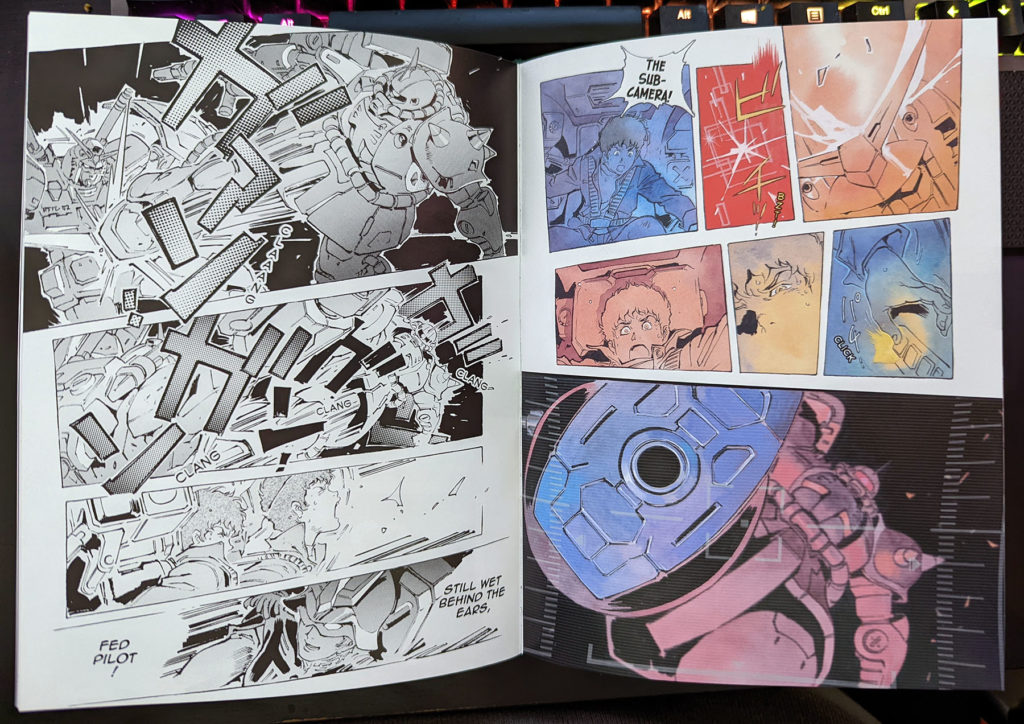
32:00 I wanna show you the difference between this mecha manga, and a contemporary mecha manga. Here’s a shot of the popular Gundam: Unicorn manga, mentioned earlier.
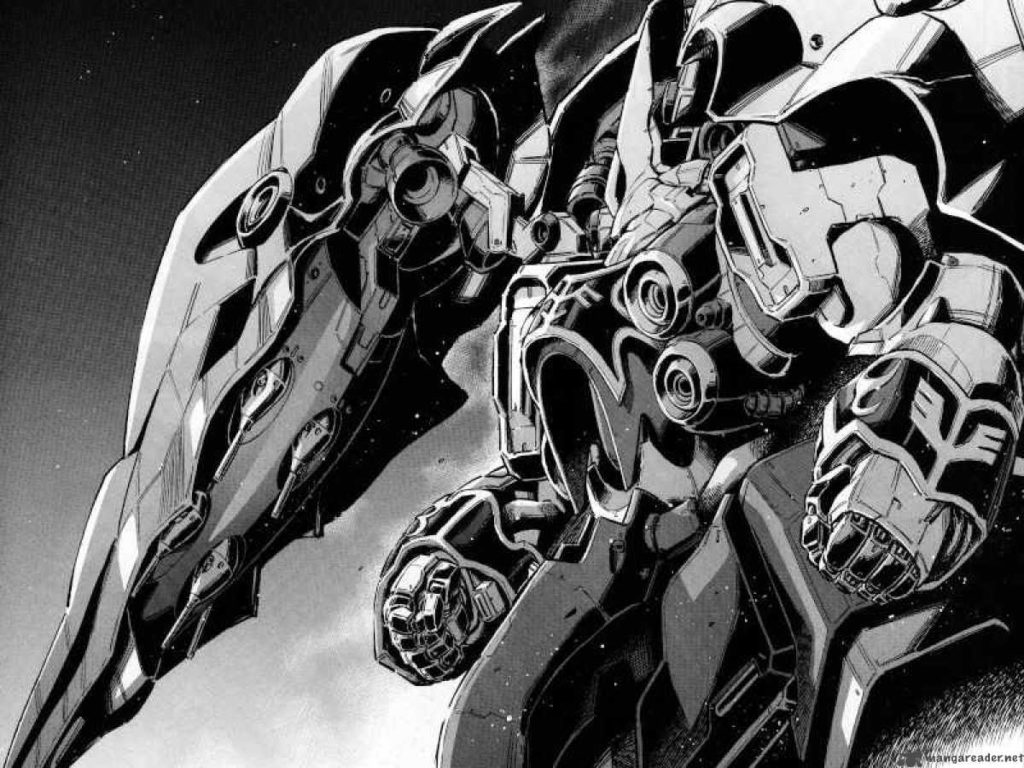
And then here’s a mecha-battle from Gundam: The Origin.
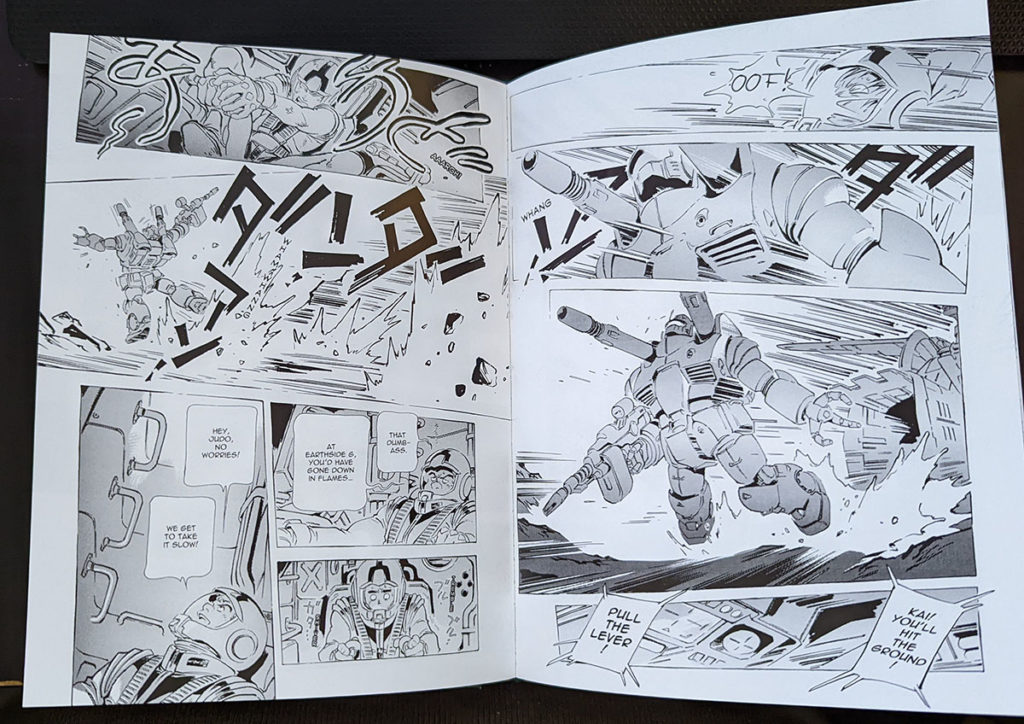
David has another good comparison in a few minutes.
33:15 Since we’re talking about mecha, I figured a good touchstone would be maybe the most popular giant robot show in North America, The Transformers. So yeah, I mention the early Dreamwave Transformers comics and illustrations, compared to the animation. This is from Pat Lee and Dreamwave Studios in 2001-ish.
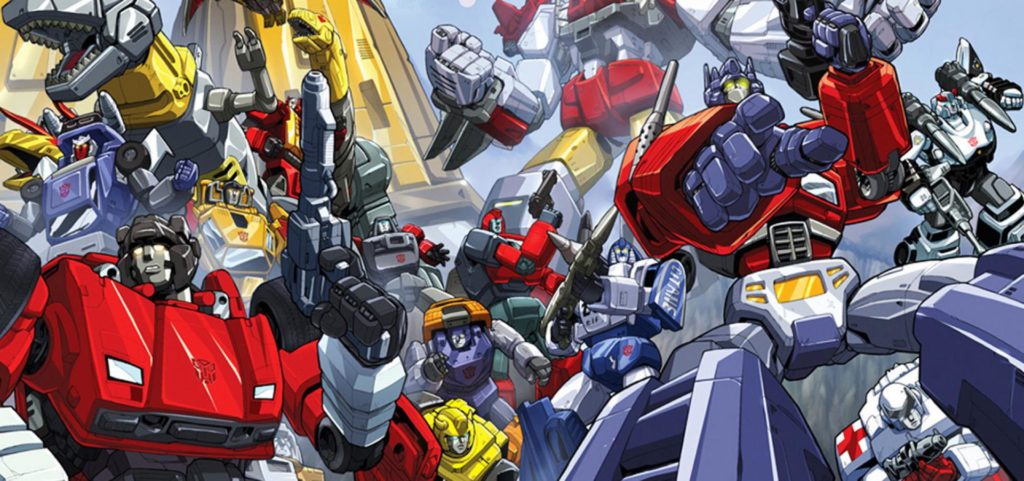
Versus a screengrab from the animation on which it was based from 1985.
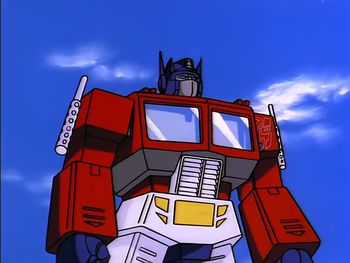
Compare that with the Transformers manga from Japan in 1984, by Masumi Kaneda, Art by Ban Magami (which is now available from VIZ Media).
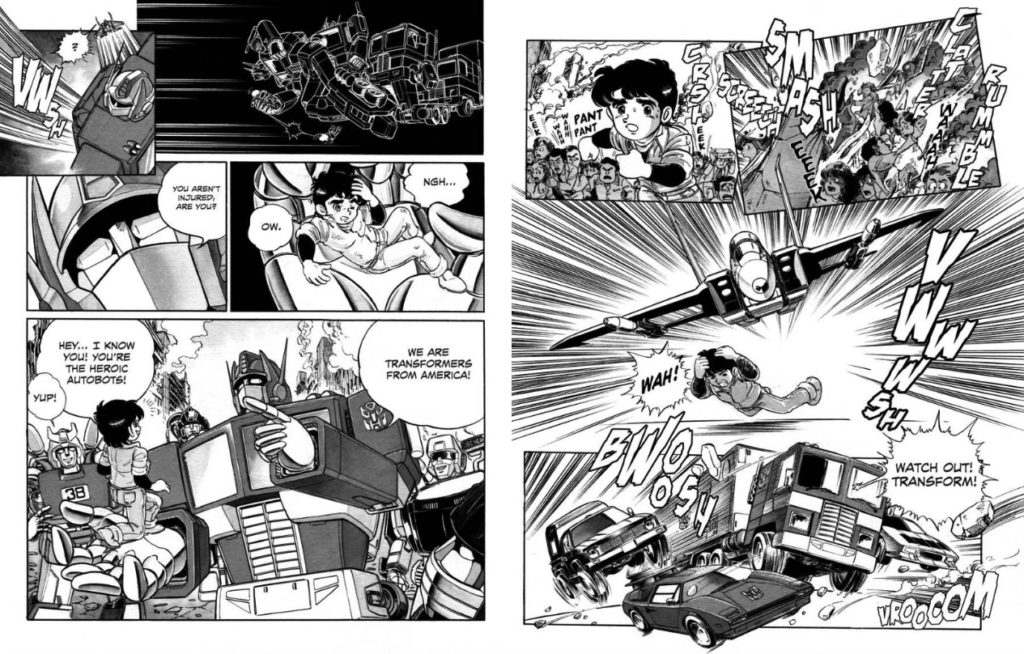
You can see differing cultural effects on the different work, and how Lee’s work was super of-the-moment, a strong updating of the original designs with a more dynamic style, and considerable more detail.
Since then artists like Alex Milne and Kei Zama have created really outstanding work for the Transformers universe, different again than anything Lee was doing, or anything prior, pushing the style further and further.
Mecha is a deep, deep well from which to draw content.
34:30 Code Geass is an anime series that was really popular for a while. It was an original anime, very Gundam-ish, and notable for having character designs by the manga group CLAMP. It’s a pretty solid anime, but the manga adaptations (which Bandai Entertainment published in English) are unnecessary, at best.
35:00 Here’s those Gundam Thunderbolt before-and-after comparisons that David mentioned:
[David:] Yasuo Ohtagaki’s original art style for Gundam: Thunderbolt (first) and his new style post-injury (second), are both pretty great for almost entirely different reasons. What brings it all together, though, is his strong storytelling sense. The series gets a lot more rounded and cartoony all of a sudden, but honestly doesn’t miss a beat.
You can find out more about his injury at this article on Anime News Network.
And since we’re talking about contemporary Gundam manga, here’s a video interview with a different Gundam manga creator, Hiro Sono, about making manga and the intricacies of Gundam. It’s good!
36:40 Yeah, people (especially ladies) really like Char Aznable. There’s a pretty solid amount of dojinshi of the dude out there, and given what he looks like in cannon stories, it’s not hard to see why, in this sequence that Deb and Chip fell in love with:
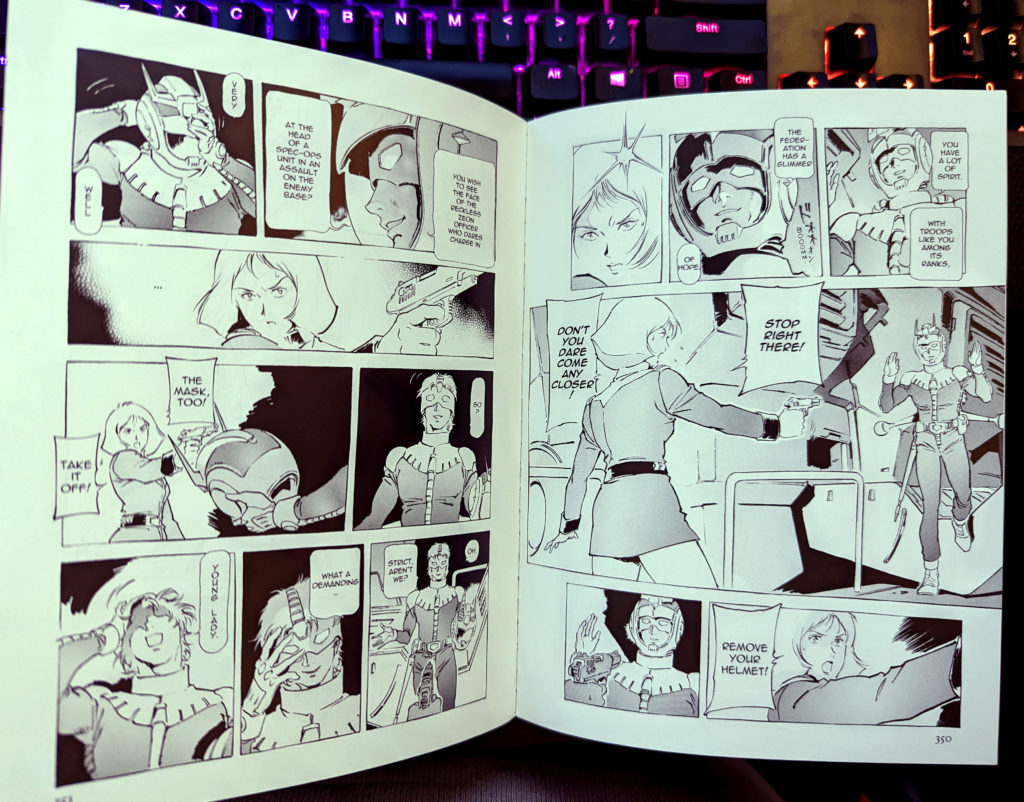
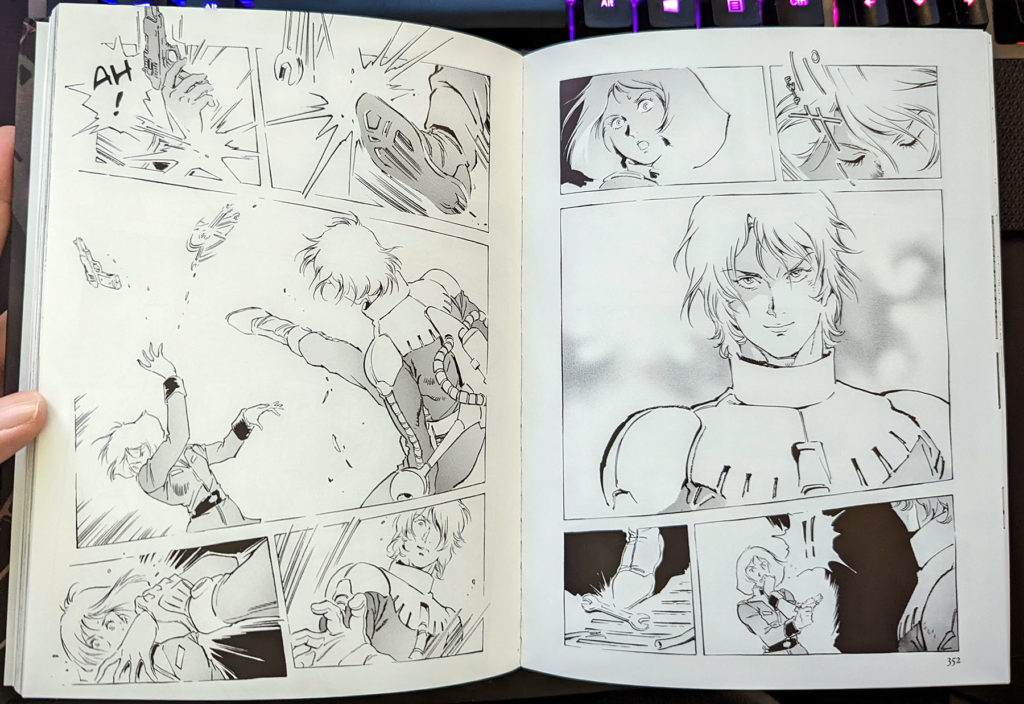
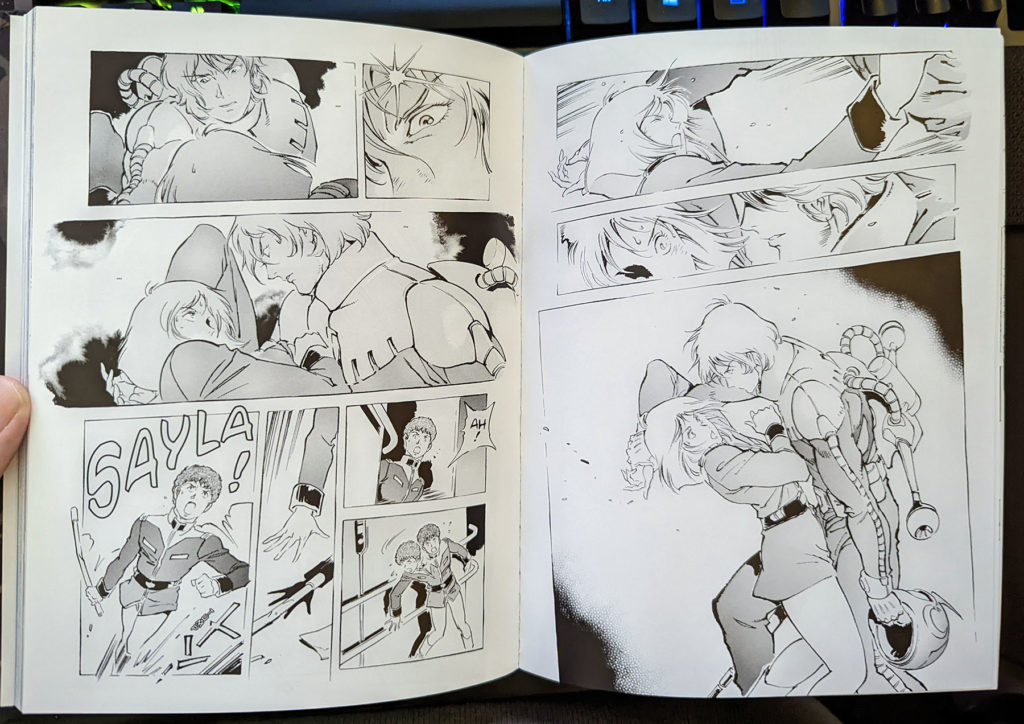
39:20 FRAW! FRAW!
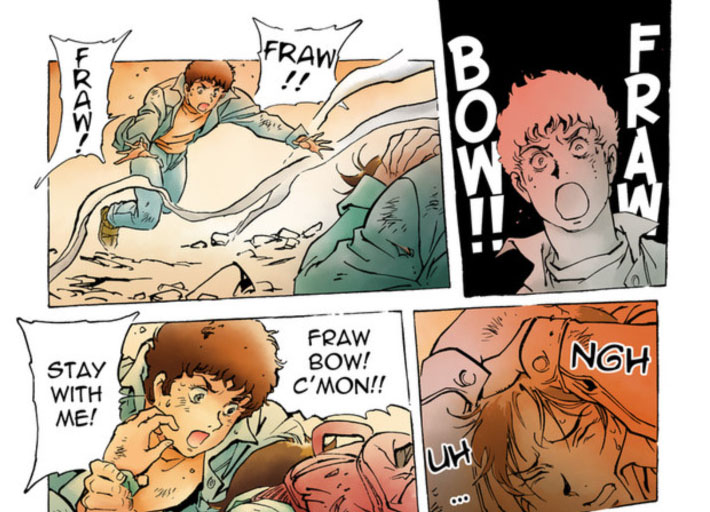
40:26 Yes, it’s true. There’s a three volume spin-off of Gundam: The Origin called “Official Guidebook” that featured ‘detailed explanations of characters, mecha, stories, and terms used.” It’s technically out of print but it’s very cheap used. Complete set on Amazon Japan for $24.
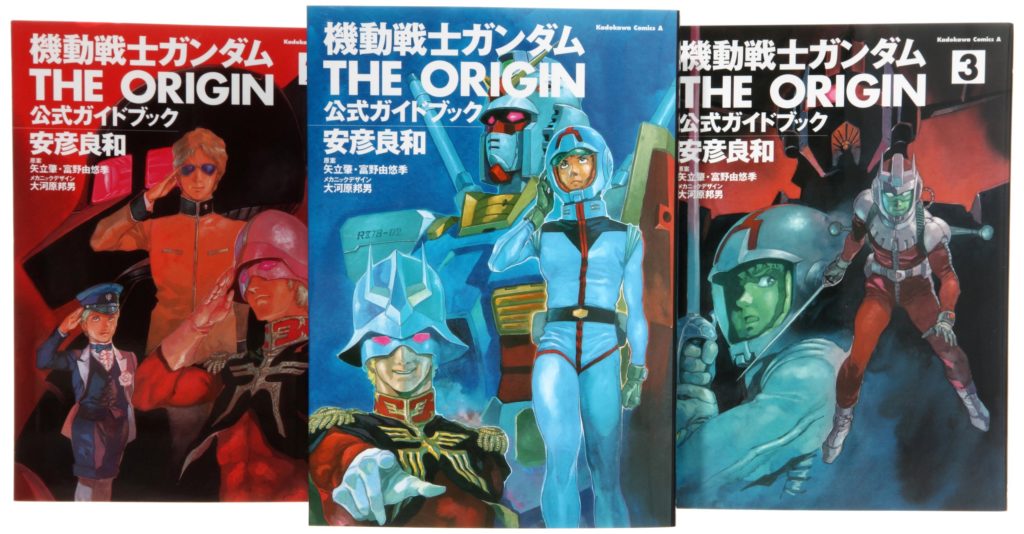
There’s also supplemental works like an illustration collection featuring colour paintings from the series, a separate guide to the animated adaptation with behind the scenes and making-of material, a completely separate book of illustrations and technical drawings for the movie adaptation of The Origin, and different, more expensive editions of that material. That first one there goes for like 300 bucks.
But wait, there’s EVEN MORE! We’re having fun here, can you tell?
[David:] A fun thing about Gundam: The Origin is that it’s fairly self-contained, right? It’s great for newbies. For more experienced fans in need of a more continuity-minded book, Junji Ohno creates Mobile Suit Gundam: The Origin: Mobile Suit Discovery: Cucuruz Doan’s Island. As you can tell by the number of colons in that single title, this book is a doozy.
First, you have to know that episode 15 of the original Gundam anime hasn’t been released outside of Japan at creator Tomino’s request due to some truly goofy off-model action, including an infamously skinny Zaku. Second, that episode was about a deserter from the Zeon side who took a bunch of orphans with him to an island to live in peace, rather than kill any more civilians. (That’s that good military otaku stuff, where you get to have your war and protest it too.) Third, you have to think that doing a prequel to a banned episode with a great story hook is a good idea.
I realize I lost you around eight words after “First,” but if you made it this far, I’ve got good news! Yoshikazu Yasuhiko is directing a film in 2022 based on the lost episode, presumably as part of the continuity of the prequel…what a time to be alive!
41:50 So just to clarify, again, about 50 episodes of the anime were condensed into three movies that are on Netflix, and that covers roughly the same ground as the 12 volume hardcover Gundam: The Origin manga series, give or take. The Origin manga was later adapted into a 4-episode Original Video Animation (OVA) series, and then another spin-off series, and you can watch those via streaming somewhere too. Plus there’s spin-offs, comedy bits, guidebooks, and more.
So, it’s exactly like American superhero comics at this point. 😉
But, to be fair, at least you can read the manga version of Mobile Suit Gundam: The Origin volumes 1 to 12 and be done if you want to.
43:00
“Gundam The Origin is less of a rollicking adventure story and more of a military procedural comic where everyone is bad at their job.”
– Christopher Butcher, Mangasplaining
43:45 I think the point that Deb makes here is 100% correct, and the fact that the war came to Japanese shores is indivisible from Japanese war stories. I think the best comic that I’ve read about World War II is Shigeru Mizuki’s Onwards Towards Our Noble Deaths, published by Drawn & Quarterly and translated by Jocelyne Allen. I think everyone should go check that one out for sure.
American war comics, war stories in general, are pretty jingoistic and come from a different place. War is always something that happens elsewhere, in those comics. Like David said, Joe Kubert can’t draw a bad looking image, and they tend to be pretty ‘gung-ho,’ even when attempting to show the horrors of war.
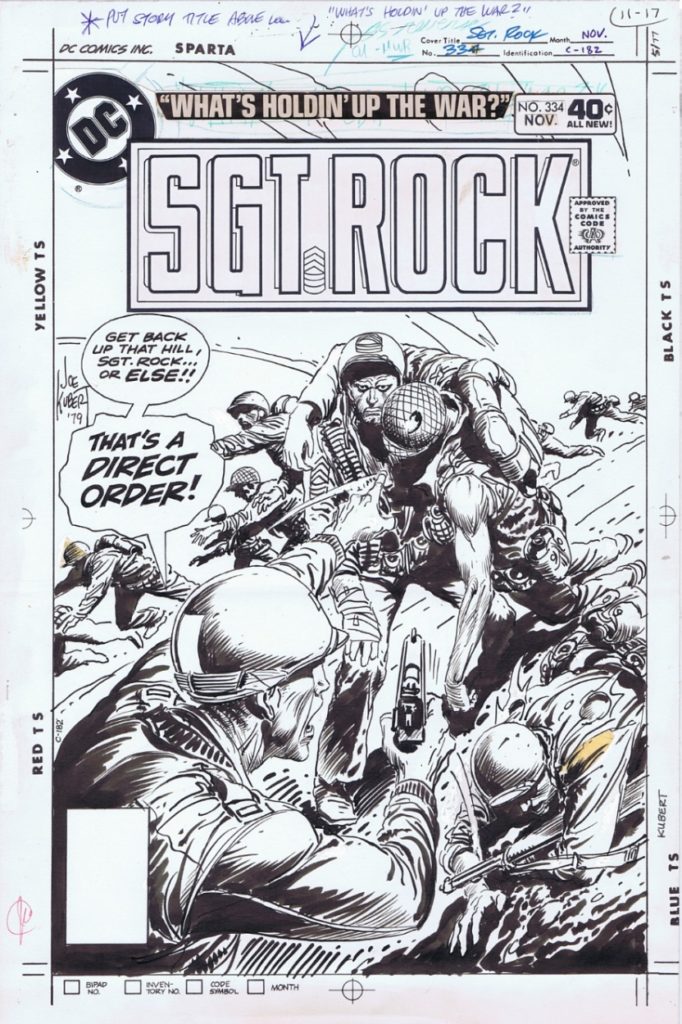
But, I think it’s important to note that there are other war comics, like the EC Comics line in the 1940s and 1950s, that are pretty different, and generally considered anti-war. I reached out to Peter Birkemoe from The Beguiling in Toronto, he’s a huge fan of EC Comics co-founder Harvey Kurtzman’s comics, EC, and comics in general, to give his take. He also sort of sponsors this podcast. Birkemoe wants me to tell you all that the following is anecdotal, but I’ll include some links to further reading below.
So Kurtzman was drafted in 1942 and fought for the Americans in WWII. He wasn’t the only veteran who became a comics maker. There are quite a few stories about Kirby’s wartime service floating around, but he was maybe the most important artist veteran to make comics about war, especially coming in the late 1940s and 1950s. Kurtzman was obsessed with showing war in all its gruesomeness, and its details, and how unglamourous and utterly awful it could be. He has a pretty damning quote that I found about war comics made before EC’s Two-Fisted Tales and Frontline Combat.
“When I thought of doing a war book, the business of what to say about war was very important to me and was uppermost in my mind because I did then feel very strongly about not wanting to say anything glamorous, and everything that went before [EC Comics series] Two-Fisted Tales had glamorized war. Nobody had done anything on the depressing aspects of war, and this, to me, was such a dumb–it was a terrible disservice to the children. In the business of children’s literature you have a responsibility, and these guys feeding this crap to the children spend their time merrily killing little buck-toothed yellow men with the butt of a rifle is terrible.
Harvey Kurtzman, 1976 – http://americanaejournal.hu/vol12no1/pecina
But that said, Peter recalled an anecdote about Kurtzman being so obsessed about the detail of war stories, the accuracy and the lack of glamour, that he couldn’t really make much of a living making those war stories. Tracking down veterans to interview, redrawing weapons and costumes a dozen times for accuracy, it took too long to make an 8-12 page story, that would be one of three featured in a given issue of a comic magazine. It’s said that he founded MAD Magazine because he could fire off gag pages and shorts that required less/no research, so he could afford to do a war story or two every now and again. Go click that link from the quote above to see more of that, it’s fascinating. Peter also recommends one or two of the big essays or interviews in The Comics Journal, here’s one by Bob Levin that was the top Google result 🙂
Also anecdotally, Peter referenced Jeet Heer’s research on newspaper adventure strip serials by Roy Crane and Milton Caniff like Buz Sawyer and Steve Canyon. When the World Wars and Korean War started, those ‘adventure’ strips became about the war, more or less, and the U.S. Military fed them extensive information to include in their strips. “Oh you’re writing a story about a submarine? Come on board our submarine!” that sort of thing — pure propaganda. Even the Sgt. Rock comics in the 1960s, which was by military veteran Joe Kubert, and it being anti-war… its impact is dulled significantly by the fact that you can’t just out-and-out kill Sgt. Rock, or his crew Easy Company. There has to be a new story featuring the character every month, and it just means the comics couldn’t tell the same kinds of stories–ones with real consequences. It’s the idea we’ve mentioned a few times now, about drawing awesome-looking wars and selling stories featuring those awesome pieces of drawing, and then being like “Yo, war is bad though.”
That’s not to say that the EC Comics material is infallible or anything. Even really good children’s literature from the 1950s might not hold up to every kind of scrutiny from adult readers in 2021, but they were trying to do something important at the time, and Fantagraphics’ black and white hardcover collections of EC comics are worth a read.
Also worth noting, Japanese-American writer and Vietnam War veteran Larry Hama, best known for more-or-less creating G.I.Joe as we know it, edited the acclaimed Marvel comic series The ‘Nam for its entire run, and that was… not a particularly jingoistic take on the Vietnam war, to my memory. It’s all up on Marvel Unlimited. Those first few issues with Michael Golden art are really outstanding.
44:15: So yeah, there’s a military attack near the beginning of volume one of this manga, and how its portrayed here in the manga versus how it was portrayed on screen in the anime in 1979 is very different. It’s very subtle here in the manga. The bodies are nearly indistinct amongst the wreckage.
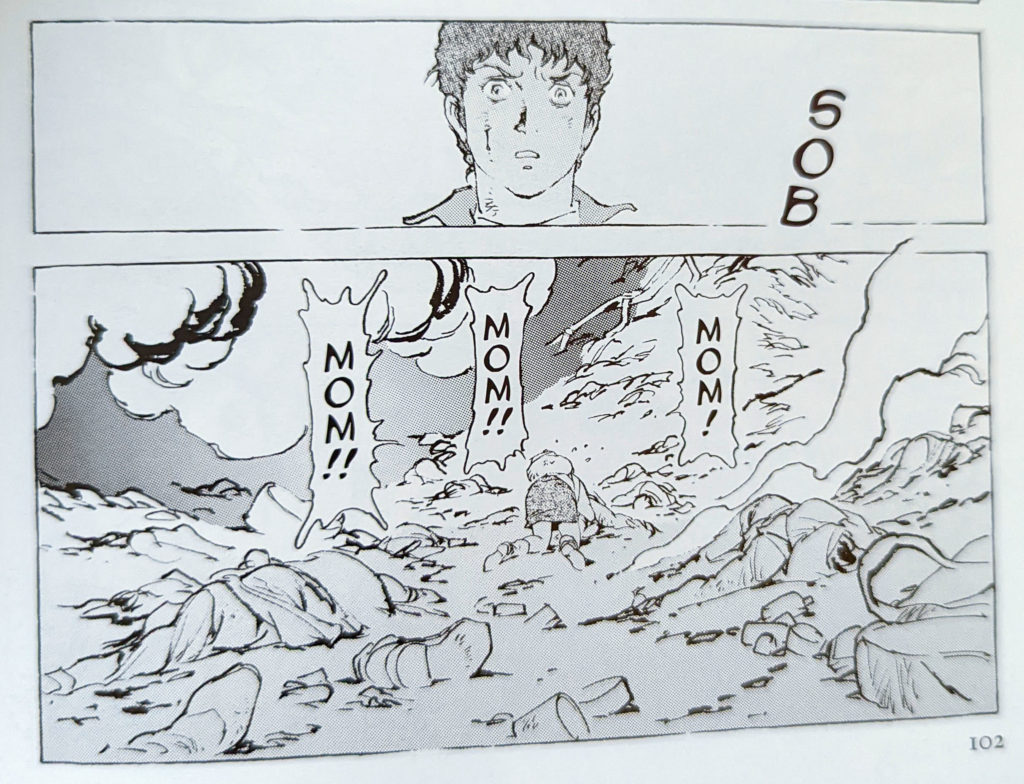
But once you’ve seen the bodies in the anime, even without too much gore, just the number of them, it gives a VERY different impression. Maybe there was a very good reason that this wasn’t shown on American TV after all!
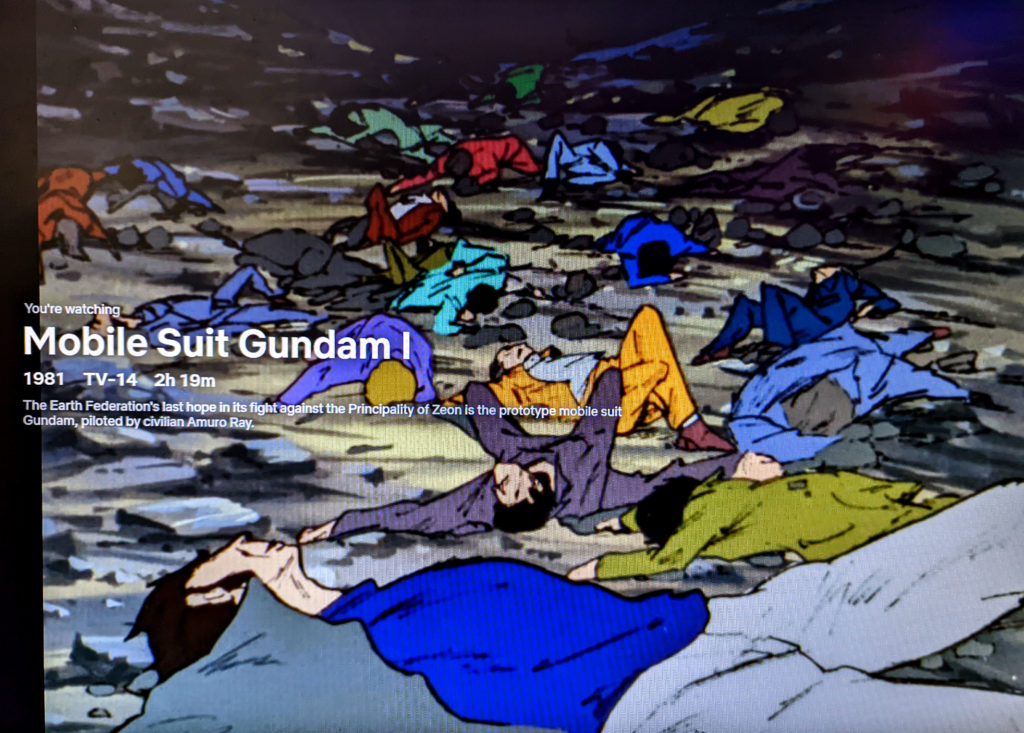
45:15 * Commercial superhero comics.
45:43 The shortest possible explanation here, is that the The Invisibles Volume 1, Issue #12, is a phenomenally written stand-alone short story called “Best Man Fall.” It’s about the life of one of the faceless soldiers murdered in the great war between chaos and order that the series portrays. This single issue is recalled in The Invisibles volume 2 in a brilliant single page illustration that I refer to. Basically, everybody has a story, a past, a life lived and a set of circumstances that got them to where they are today. Even the faceless soldiers working for the ‘bad guys’.
You can (and should!) read a greater description of this issue here.
Anyway, I was going to go grab the image I was talking about, but I can’t afford to read 200 pages of The Invisibles right now, as I’m on a deadline with this. But like David says, read “Best Man Fall,” essentially. 🙂
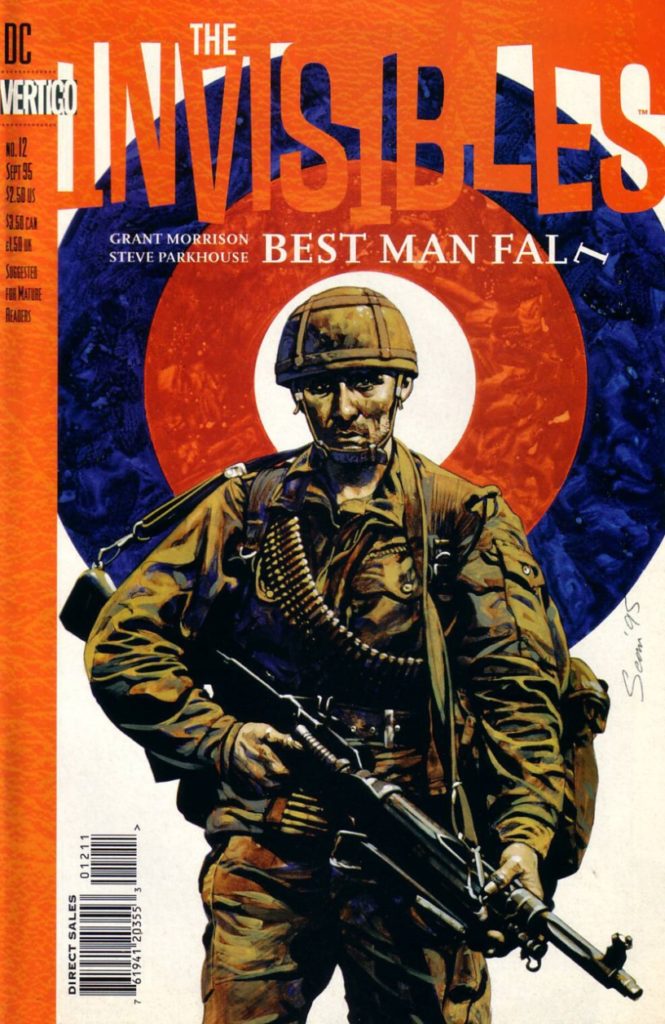
47:20 Quick shout-out to David’s observation about war comics from the West being about personal achievement, and war comics from Japan being about organizational achievement. Char in this series is all about (his) personal achievement, and his army is headquartered in Hollywood, USA (as it exists in the Gundam Universe). Blond, blue-eyed Char is clearly an American stand-in in some ways, and his mode of being a loner, a rebel (dottie), comes from that… I feel like someone’s already written a university dissertation about this.
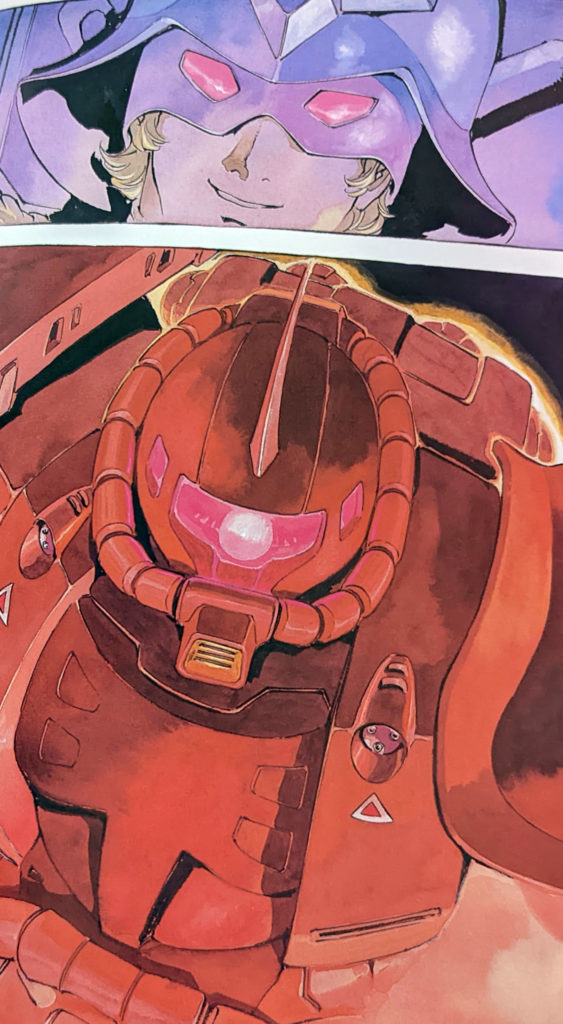
49:05 Specific actions are clear, but the overall effect is still chaotic, like ripping the faceplate off of the Zaku.
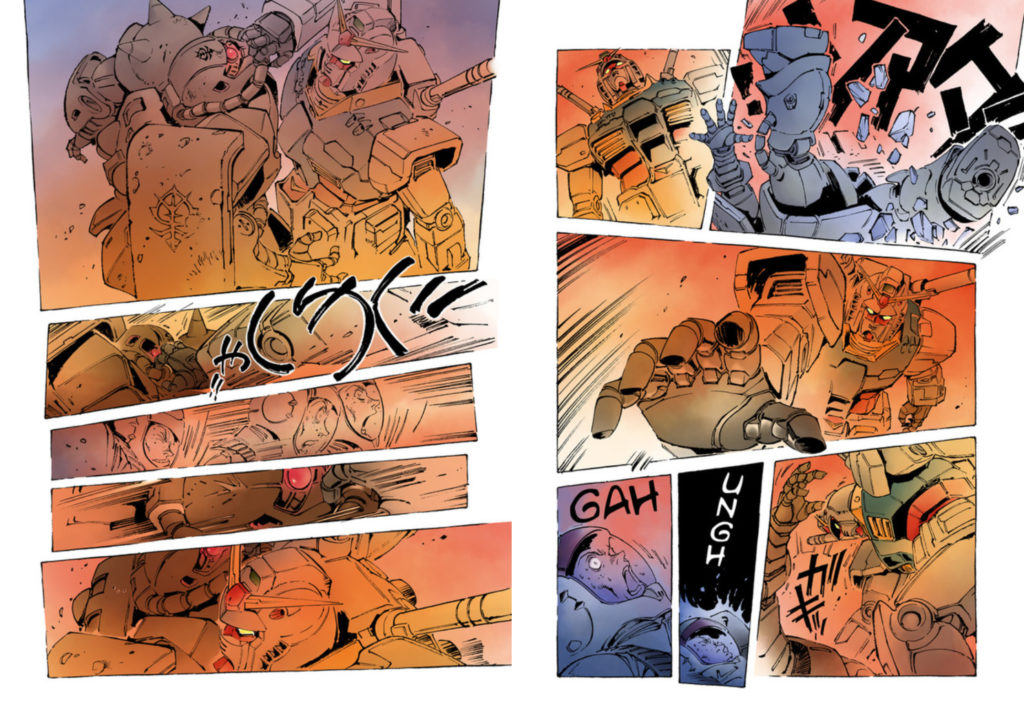
51:00 Yeah, the Gundam model kit recycling program is pretty cool! To explain briefly, the pieces that make up the Gundam models are held together by bits of plastic piping, which you ‘snap’ the main pieces out of. Historically, that plastic piping has been thrown away (and still probably, largely is). However, Bandai, makers of Gundam model kits, has opened up a recycling project where you can send back your excess Gundam-related plastic: https://bandai-hobby.net/site/ecoplaproject/en/
Some of that plastic is turned into new kits, some of it is turned into pretty darned cool giant robot art:

Check out the full story at Anime News Network. https://www.animenewsnetwork.com/interest/2021-11-23/life-sized-gundam-head-made-from-recycled-gunpla-kits-unveiled/.179882
This is probably a bit of greenwashing, in all honesty. At the end of the day, there’s still a ton of plastic waste being produced, but it’s cool to see that at least they recognize it’s a problem and are taking steps. I know the LEGO Group is moving toward making some bricks from recycled materials these days too. Maybe we can have our cake and eat it too? Probably not tho!
52:00 David mentions the Gundam G-40 Proptotype, designed in real life by Ken Okuyama, is a contemporary redesign of the original Gundam. You can read more about it here.
There was also a Short animation previews created for a short film that utilizes the new design:
(Federation Force version)
(Zeon Version)
52:30 “Kraven’s Last Hunt” is a popular story featuring Spider-Man and one of his many villains, Kraven The Hunter. It was notable for being a shocking, somewhat mature, edgy, creepy story for its time (1987), and something of an ‘event’ as the storyline crossed over into all three monthly Spider-Man comics at the time, for two months, and featured the ‘deaths’ of several characters. It remains a favourite outing among Spider-Man fans. It has spun-off numerous major follow-up stories. Including one by our good pal, Chip!
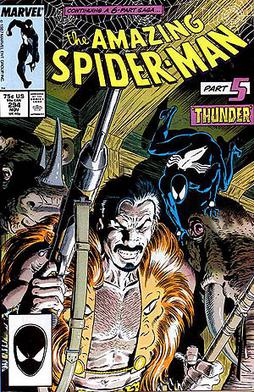
52:50 As mentioned, the goofy, daily slice-of-life comic about mass murderer and war criminal Char Aznable is Char’s Daily Life, available on Bookwalker.

There’s also the four-panel gag manga about Char and the boys, Mobile Suit Gundam San.
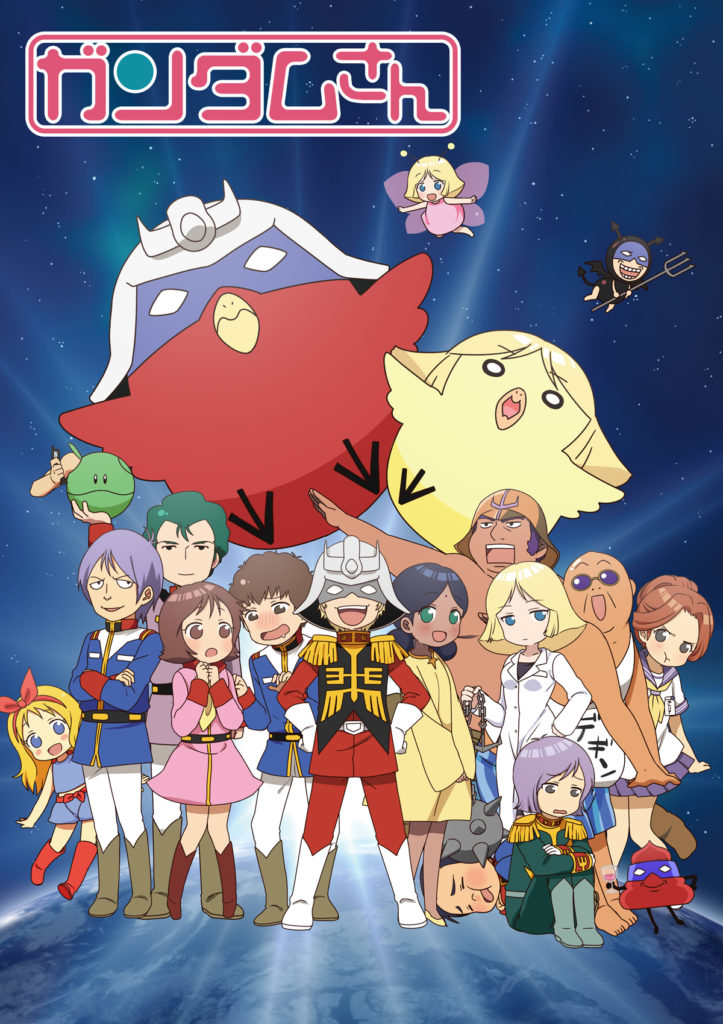
And I think there’s even ANOTHER one that might only be available in Japanese, called Mobile Suit Gundam: The Origin: The Whole Farce Char Aznable.
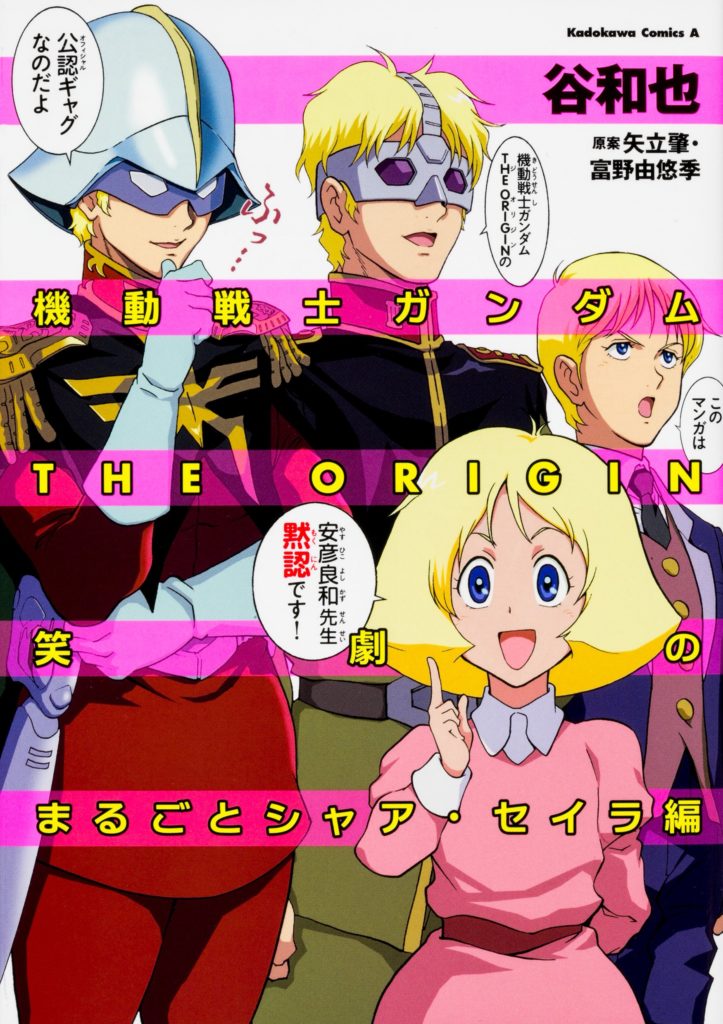
The fun never stops!
54:00 Deb shouts out a couple amazing ladies making awesome mecha comics and illustrations. Mecha aren’t just for boys, after all.
Kei Zama: Primarily known for drawing Transformers comics for IDW, also doing an Avengers Mecha comic for Marvel, and some Star Wars stuff too! https://keizama.com/
Q Hayashida: Author of Dorohedoro and Dai Dark, both very dark, street-level titles which include mecha and other grungy, gritty, cyberpunk sorta stuff. The former is out in English (and largely OOP) from VIZ Media, the latter is serializing now from Seven Seas. https://m-hz.net/
Emma Rios: Good news, we have a WHOLE INTERVIEW with Emma Rios at the end of this episode! Keep scrolling.
55:10 But that said, the STEREOTYPE is that only boys like mecha, like we can see from this epic spread in One Piece, where the character Frankie transforms into a giant robot and fires a laser, and Usopp and Chopper love it! Robin and Nami don’t give a shit. Robin, in particular, is completely unimpressed by the almighty Big Emperor…
55:30 Giant Robot creation in 20th Century Boys by Naoki Urasawa is one of the keys of the series, don’t wanna get tooooo deep into it here, it’s pure spoilers. But here’s the sequence Deb is talking about, I think it’s mostly spoiler-free.
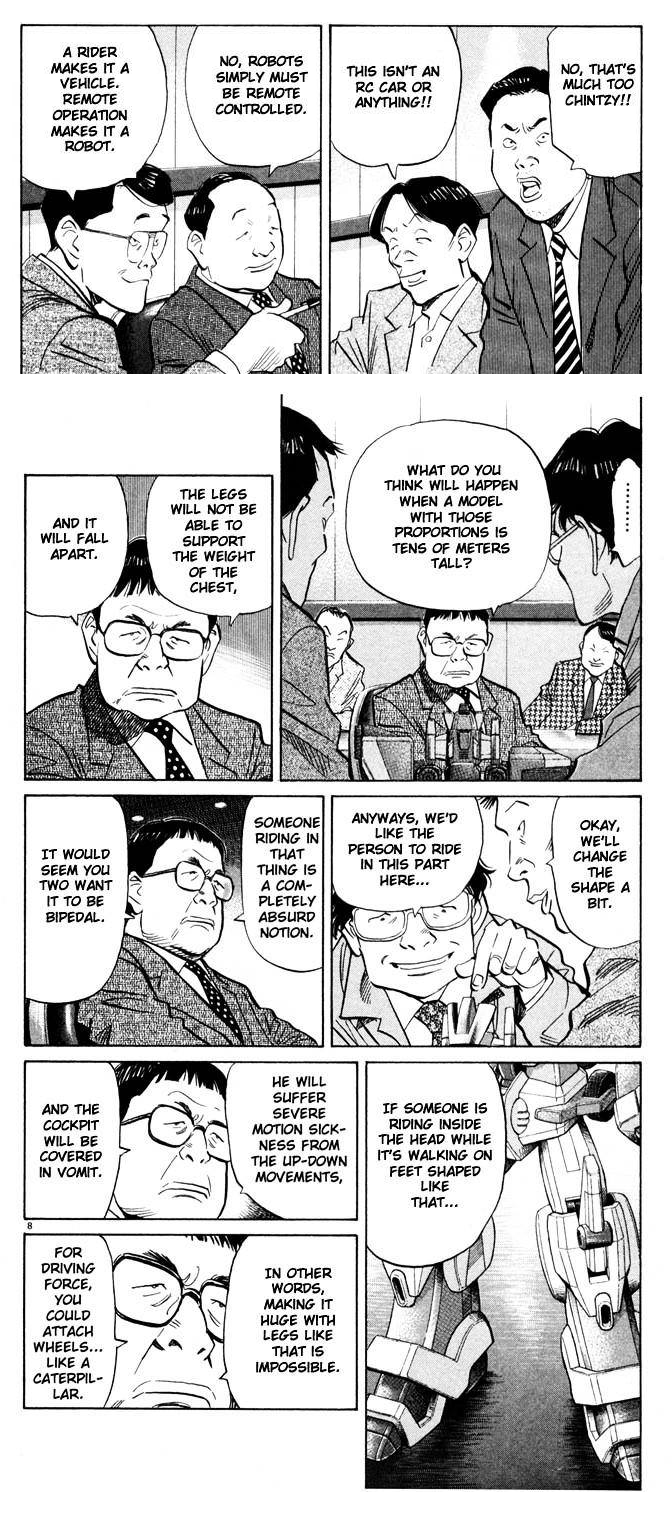
57:00 What’s a Gigantor? Well, answering questions like that are what the show notes are all about!
The manga series Tetsujin 28-go was created in 1956 by manga-ka Mitsuteru Yokoyama. It featured the titular giant robot Tetsujin 28 (lit. Iron Man), controlled by a young boy named Shotaro Kaneda. They would stop bad guys, go on adventures, that sort of thing. While never quite as big inside or outside of Japan as characters like Astro Boy, the manga did run for 24 volumes, and it spawned numerous anime and other spin-offs.
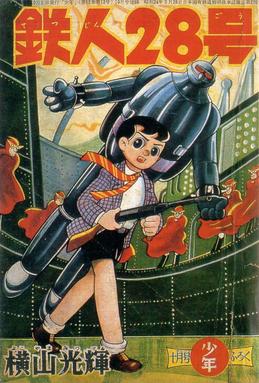
Tetsujin 28 is still a powerful image, and holds deep nostalgic appeal to Japanese of a certain age. Author Yokoyama’s hometown of Kobe, Japan, erected a massive statue of Tetsujin-28 in 2009 to commemorate the devastating 2005 Great Hanshin Earthquake that did massive damage to the city of Kobe, and to ‘protect’ against future catastrophes.

So what does that have to do with “Gigantor?” I’m getting there!
As with a LOT of popular robot manga, Tetsujin-28 got an animated adaptation! From 1963-1966, 97 episodes of Tetsujin 28-go aired on Japanese TV! And maybe you can see where this is going now? Like lots of imported material, Tetsujin 28-go was brought to North America and rebranded as Gigantor!, with 56 of its episodes dubbed into English, and featuring heavily-adapted and re-written scripts. Shotaro Kaneda became Jimmy Sparks, and the rest is history.
58:40 Yeah, I don’t really know what to write about the D&D setting/novel series Dragonlance that I didn’t say on podcast. And no shade, we all have influences and you don’t write a few dozen books without having something of your own to say… But like, Fizban literally dies and comes back to life you guys, Gandalf much? Anyway, it’s fine. The stuff with Raistlin was pretty cool.
All of that said, it’s important to read foundational works, to see what influenced and shaped the things we have now.
1:03:00 Alright! Here it is, the bad-ass kit that Deb bought for David. It’s clear! It’s neat! It’s GUNDAM!
1:06:00 Shin-Godzilla is a 2016 film directed by Hideki Anno, creator of Neon Genesis Evangelion, which as mentioned this episode was deeply influenced by Gundam. And as mentioned by David, volume 1 of Mobile Suit Gundam: The Origin, contains a short essay by Anno, a bit ‘kids these days’ sure, but a really interesting bit of writing about the importance of creating big stories. The essay is titled “Celebrating the revival of Gundam as a tale!”
1:07:30 THE BREAK! Please note that after this point, all time-stamps are approximate at best due to dynamic ad insertion.
And now it’s time for another exciting installment of the occasional segment MANGASPLAINING: LISTEN TO ME!

This time, David interviews accomplished comic creator Emma Ríos. Born in Spain and now creating work for both the American and European markets, Ríos is best known to Western comics fans for her work on Mirror (with Malaysian artist Hwei Lim), Pretty Deadly (with Kelly Sue DeConnick), and I.D., both published by Image Comics. Ríos also worked on titles like Hexed for BOOM, and Doctor Strange and Runaways for Marvel. You can find her on Twitter. https://twitter.com/emmartian
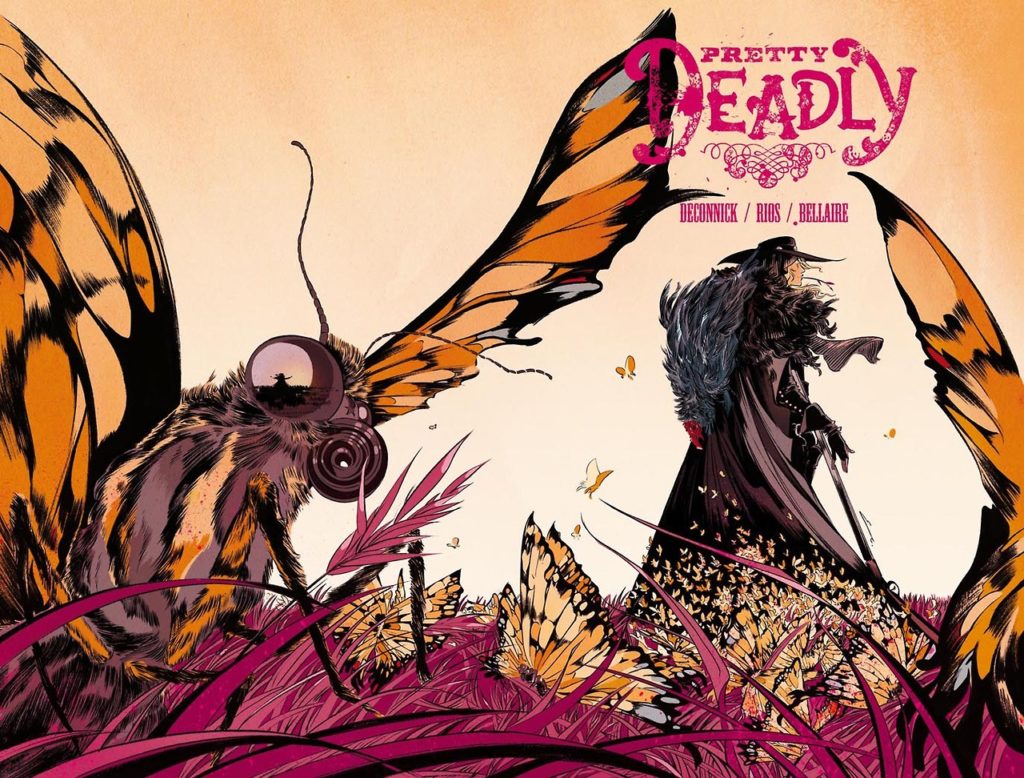
Also, special shout-out to David for compiling the following show notes!
1:10:38 The first Gundam Emma saw was 0079, also known as First Gundam, also known as Mobile Suit Gundam!
1:12:15 Gundam Wing was the introduction to Gundam for a lot of the west, thanks in no small part to Cartoon Network. The series featured pretty boys, incredible robots, and righteous violence. In what may or may not be a sharp contrast to First Gundam, the characters were a bit less ambivalent about violence than our beloved soft boy Amuro Ray.
1:13:32 Char is…a handsome guy. Here’s proof:
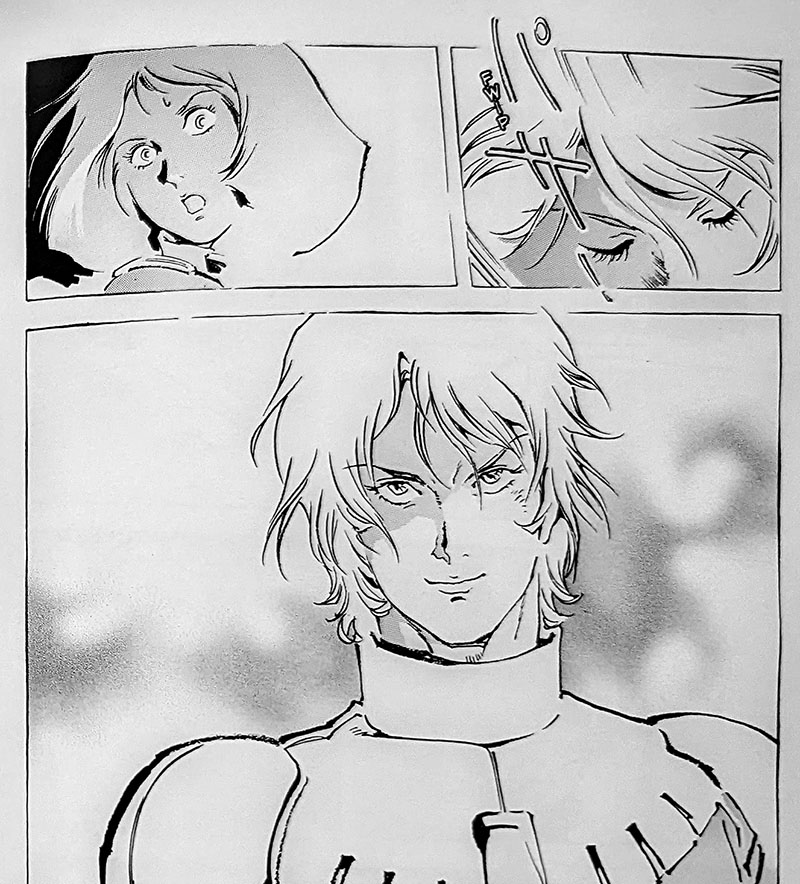
1:14:20 Emma mentions that Char is capable of evil, an aspect of his character that was featured to great effect in Mobile Suit Gundam: Char’s Counter Attack, the final confrontation between him and Amuro Ray. You can see another side of Char in Zeta Gundam, the sequel series to First Gundam. In it, Char is masquerading as Quattro Bajeena and fighting on the side of the angels. People frequently saw straight through his disguise on account of…the Char of it all.
1:14:35 “Power corrupts” is a great phrase, and the full quote from Lord Acton is a fun one to mull over: “Power tends to corrupt, and absolute power corrupts absolutely. Great men are almost always bad men, even when they exercise influence and not authority, still more when you superadd the tendency or the certainty of corruption by authority.” He was in a conversation about the history of the Inquisition, which was (to say the least) a period of time when a lot of holy people did a lot of sinful deeds. If a Pope can’t hack it, what chance does a handsome devil like Char have?
1:15:25 Amuro Ray and Kamille Bidan are the main characters of First Gundam and Zeta Gundam respectively. Like Amuro, Kamille has no interest in fighting, and in fact, is made to pay the price for the sins of the adults who command and associate with him several times. Bright Noa is present in both series, a rookie in the first and a seasoned veteran in the second. He doesn’t provide a moral compass so much as a sign of how even nominally good men are capable of making bad or ruthless decisions.
1:15:48 If you haven’t seen Neon Genesis Evangelion or Gundam, the most obvious similarity may be that they both feature extremely cool-looking giant robots. But the real fun is where creator Hideaki Anno brings his Gundam influence to bear, resulting in a cast of characters who mostly absolutely do not want to be where they are and doing what they do. Compare Bright Noa and Misato Katsuragi’s semi-parental roles with Amuro Ray and Shinji Ikari, for instance.
1:16:00 If you don’t watch westerns, boy, have we got a cool thing for you. In 1966, Sergio Corbucci wrote and co-directed Django, starring Franco Nero. In addition to being incredibly violent, it’s very much a product of its time… and also one of the best spaghetti westerns ever made. Django walks around dragging a coffin behind him, which is what put David in mind of the Full Armor Gundam from Gundam Thunderbolt, who uses coffin-like shields for protection. Django has a fantastic final scene and a killer score. Even if you don’t like westerns, give the main theme by Louis Bacalov a spin.
1:17:51 David mentions that Emma and Sarah Horrocks are probably the biggest Gundam fan friends he has. Sarah makes comics too, and they come highly recommended. Check them out here: https://mercurialblonde.squarespace.com/comics
1:18:05 NHK made a documentary named Making Gundam: The Inside Story, digging deep into the history and evolution of the show. It’s not currently available legally, but it shows up on the official NHK YouTube channel or website on occasion! You can read a bit about it here, on Otaquest: https://www.otaquest.com/mobile-suit-gundam-documentary-nhk-world/
1:18:18 How to succinctly explain Space Battleship Yamato (a.k.a. Star Blazers)…. When Gundam started blowing up, the reaction was “Gundam is the new Yamato!” The first Space Battleship Yamato movie beat Star Wars in Japan, thus guaranteeing a sequel. Gundam was a giant robot series, but Yamato—debuting in 1974 as an anime and comic both—was a sci-fi tale about a battleship in space. The more mature storytelling in that series set a firm foundation for future anime, including Gundam.
[Deb:] The manga version of Space Battleship Yamato by Leiji Matsumoto is available from Seven Seas.
1:18:50 Fans sending correspondence to support shows and manga has a long history in Japan! Series in Weekly Shonen Jump, for instance, have found grassroots support via fans sending postcards into the editorial office to demonstrate how much they love the series. It’s cute, and, depending on the fandom, can result in an overwhelming amount of mail. But what better way to prove the entire country loves a series than by filling an entire room with postcards about how cute Char is? On a related note, we need a hand sending a 430-pound box to Japan, if any of our listeners own a shipping company and are willing to work for cheap.
1:20:00 First Gundam‘s atmosphere incorporates shoujo manga vibes on occasion, as does Zeta Gundam’s status quo for Amuro. The heroes aren’t just the rough and ready-for-action types, but more sensitive and gentle on occasion, or something even absolutely bad for you but irresistible.
1:20:15 “Women in the fridge” is a reference to the frequency of how often women are killed in comic books, and pop culture more generally. The phrase derives from the fact that a Green Lantern once came home to find his girlfriend murdered and stuffed in his fridge. This kind of “killing, maiming, or depowering” happened frequently to women as a way of motivating the generally male characters who were associated with them. In Gundam, however, Tomino created so many female characters that even though “Kill ‘Em All” Tomino certainly lives up to his name, it rarely feels like any woman character was sacrificed for someone else. Instead, their ends to be on their own terms.
1:22:25 🤭
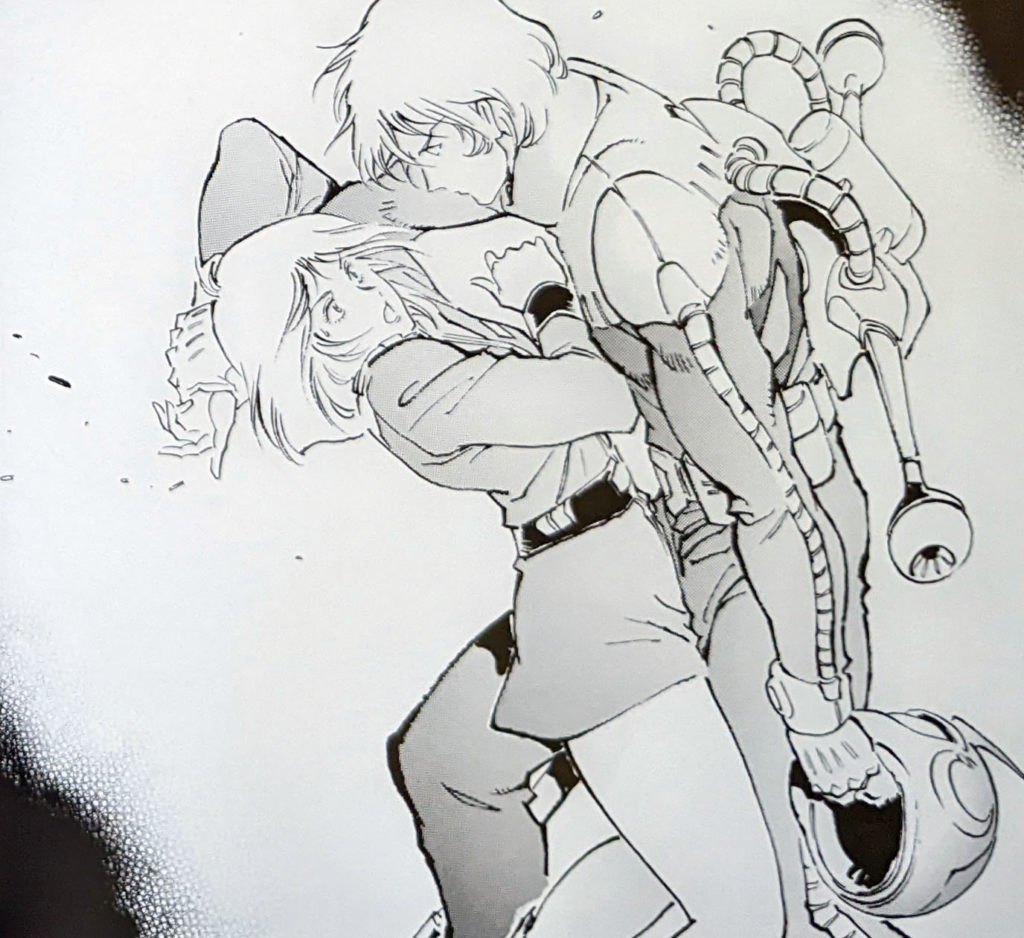
1:23:40 Yoshikazu Yasuhiko got sick during the production of First Gundam! You can find more details here, on Cries In Newtype.
1:24:47 Speaking of Dad & Dad, Yaz & Tomino were interviewed in My Anime in 1981, shortly after the announcement of the second Gundam film. The fine folks at Wave Motion Cannon translated the old interview. You can get a glimpse of their differing approaches to the material even then, as Tomino casually mentions that he would prefer not to, but that a storyline with the characters Kai and Miharu would be cut, while Yaz closes on a flat statement about how much he likes Miharu’s episodes.
1:24:56 Remakes are a shaky thing sometimes, especially ones that indulge in a bit of… revision, let’s say. But in this case, it’s remarkably legit for Yaz to create this reworking of First Gundam. He was there at the beginning, and provided a crucial and beloved contribution to the original. It’s sort of like if Steve Ditko came back to do The Morally Consistent Spider-Man around the time Sam Raimi and Tobey Maguire brought the superhero to theaters.
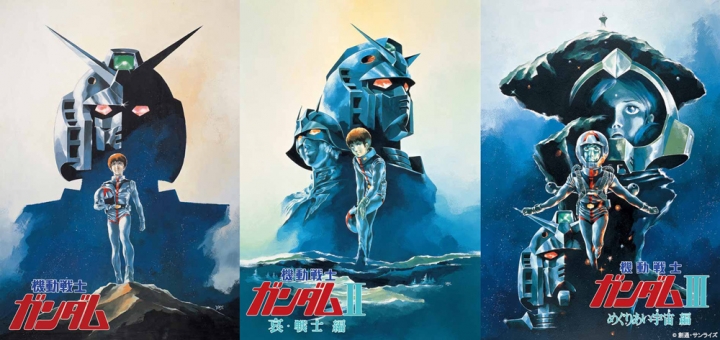
1:26:03 Mobile Suit Gundam ran for 43 episodes before eventually being collected into a series of three compilation films released from 1981 through 1982. They condensed the story down to feature length using old footage and a few pivotal new additions. The films were a hit, to say the least, and—in concert with the Gundam model kits known as “gunpla”—helped solidify the series as one of the biggest and baddest franchises on the block.
1:26:25 Summary movies can be dangerous! David read the Gundam Thunderbolt manga by Yasuo Ohtagaki after a few energetic recommendations online and really enjoyed it. When he saw the movies, though…they’re good. But they lose a lot of material from the manga, you know? A lot of charm.
1:26:35 Tuesday, December 14, 2021 was an amazing day for a lot of Americans. The theatrical edition of Macross Plus came to theaters in a limited engagement. This is notable because it’s the first time we’ve had the chance to see the film in theaters.
1:28:30 The moment Emma loves is when Amuro replies “Don’t flatter me” after Sayla goes to cheer him up. It’s a striking scene, one you’d expect from Steve Ditko-era Peter Parker, maybe, rather than the hero of a war manga.
1:29:53 “Get in the Eva, Shinji!” is a popular quote and meme derived from Hideaki Anno’s television anime Neon Genesis Evangelion. Fans use it as a joke sometimes, but the phrase references the way Shinji Ikari was forced to pilot a machine by the adults who were responsible for his wellbeing. Zac Bertschy wrote an incredible essay about it, released on the day Evangelion hit Netflix and suddenly became super-accessible to a new generation of fans. It’s called “Get In The Robot, Shinji,” and it’s one of David’s favorite critical pieces.
1:31:30 Emma’s Anzuelo is coming from Image Comics in the future, and everyone’s fourth-favorite Mangasplaining co-host David Brothers is editing it! In the meantime, please check out her solo graphic novel ID, an examination of identity and finding your way, in addition to Mirror, with Hwei Lim, and Pretty Deadly, with Kelly Sue DeConnick.
1:31:44 THE SECOND BREAK! WOO-HOO! TIME STAMPS ARE EVEN FURTHER OUT OF WHACK!
SHOUT OUTS!
David shouts-out The Men Who Created Gundam, a manga about the creators of the Gundam series by mangaka Hideki Owada. The book from Denpa Books has been bumped back a little bit, and is now scheduled to be released in June, 2022. (Though that shouldn’t stop you from pre-ordering this book)
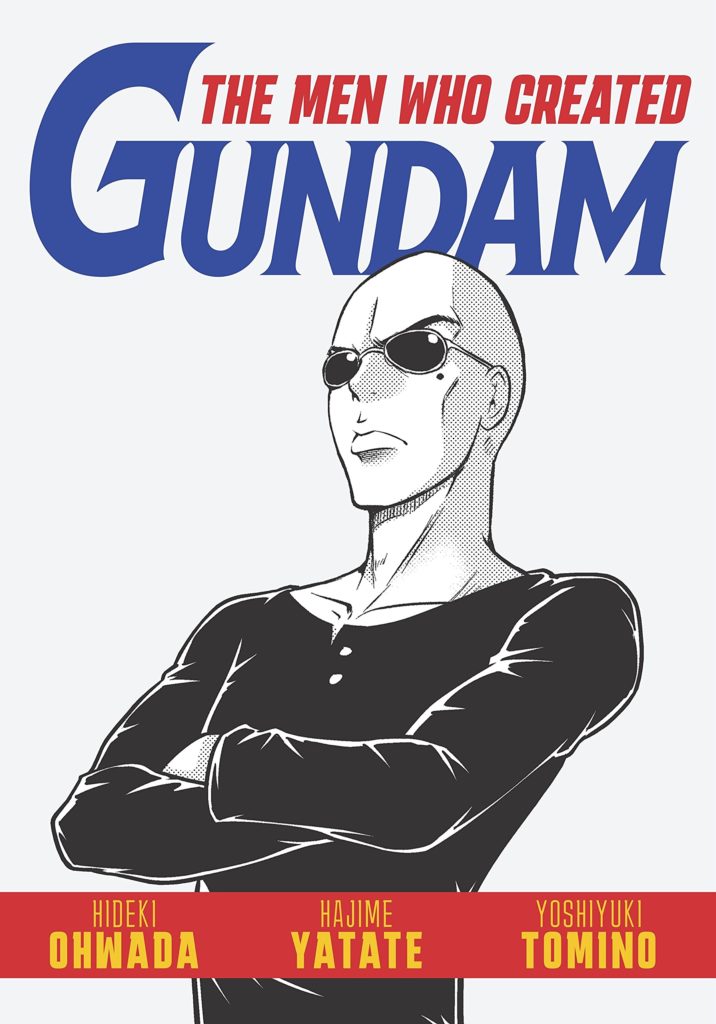
Deb recommends Robo-Sapiens: Tales of Tomorrow, by Toranosuke Shimada and out now from Seven Seas Publishing.
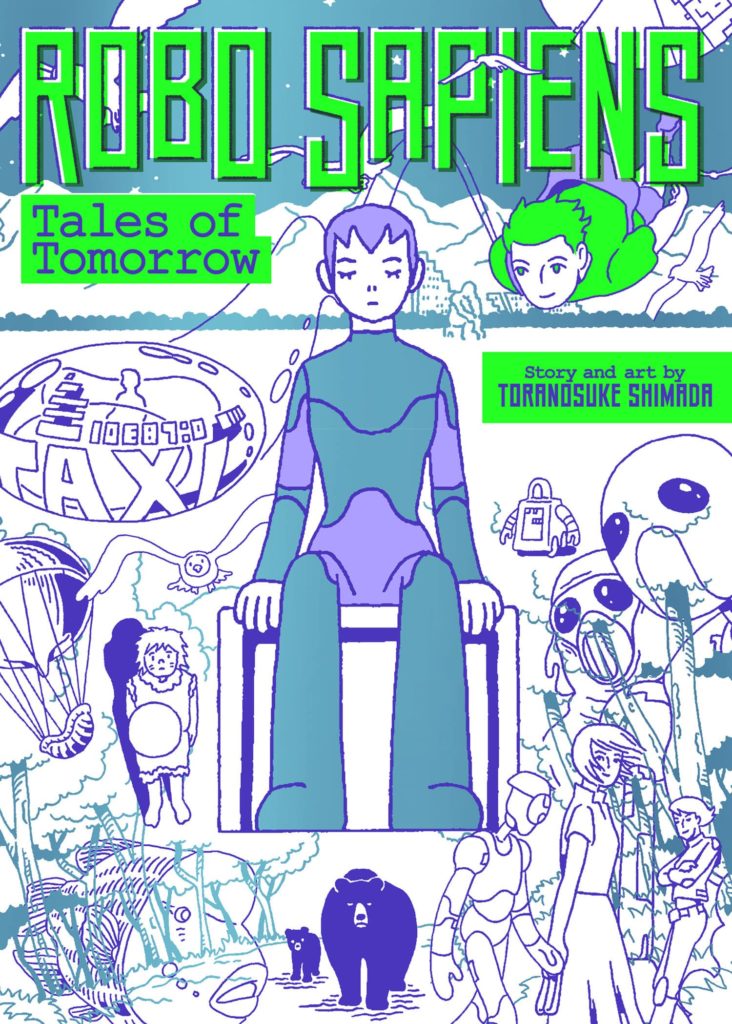
Christopher recommends Neon Genesis Evangelion, the manga. It’s by Yoshiyuki Sadamoto, and it’s an alternate telling of the same story covered in the anime. It’s available digitally from VIZ, and there’s multiple print editions that are all out of print.
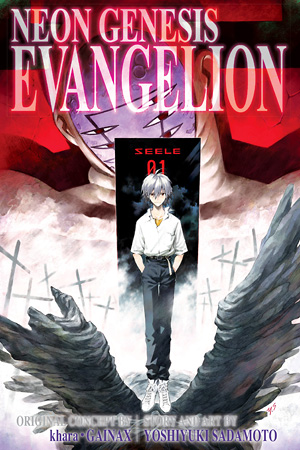
Chip shouts out Unforgiven, the film with Clint Eastwood.
And that’s the episode!
Thanks so much for listening!
As a reminder, you can find a comic store near you at comicshoplocator.com. You should also visit your local library, they probably have tons of manga to lend in either print or digital formats.
Also check out Mangasplaining theme song composer D.A.D.S. on Spotify.
See you next week for a special Mangasplaining: Listen to Me! episode featuring our chats with translator Jocelyne Allen and Vinland Saga editor Ben Applegate!
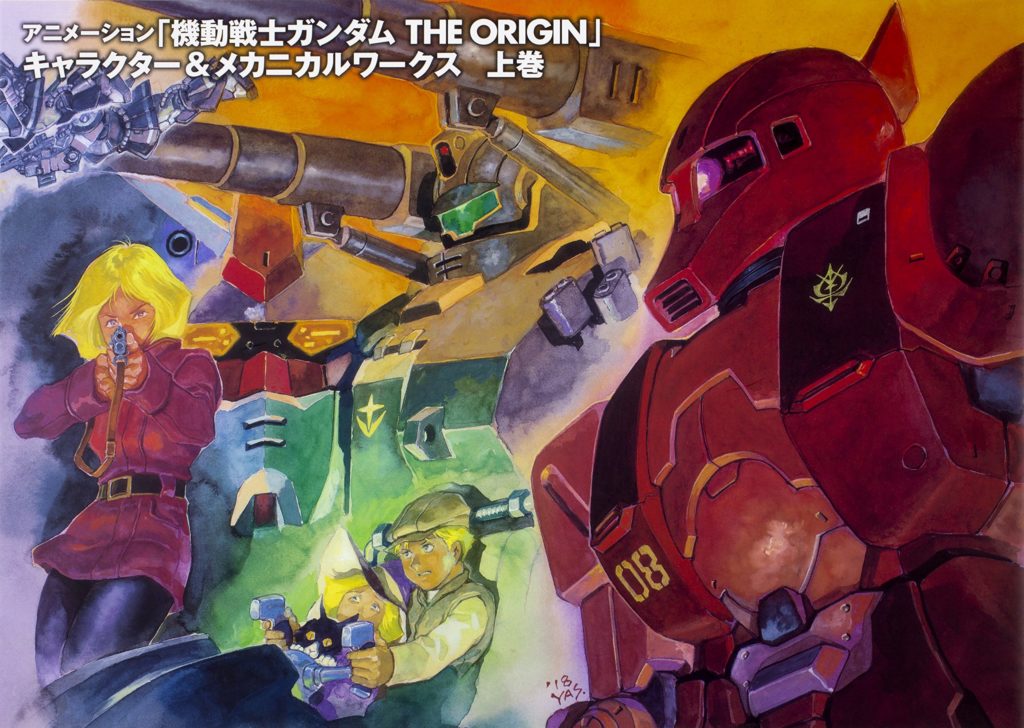

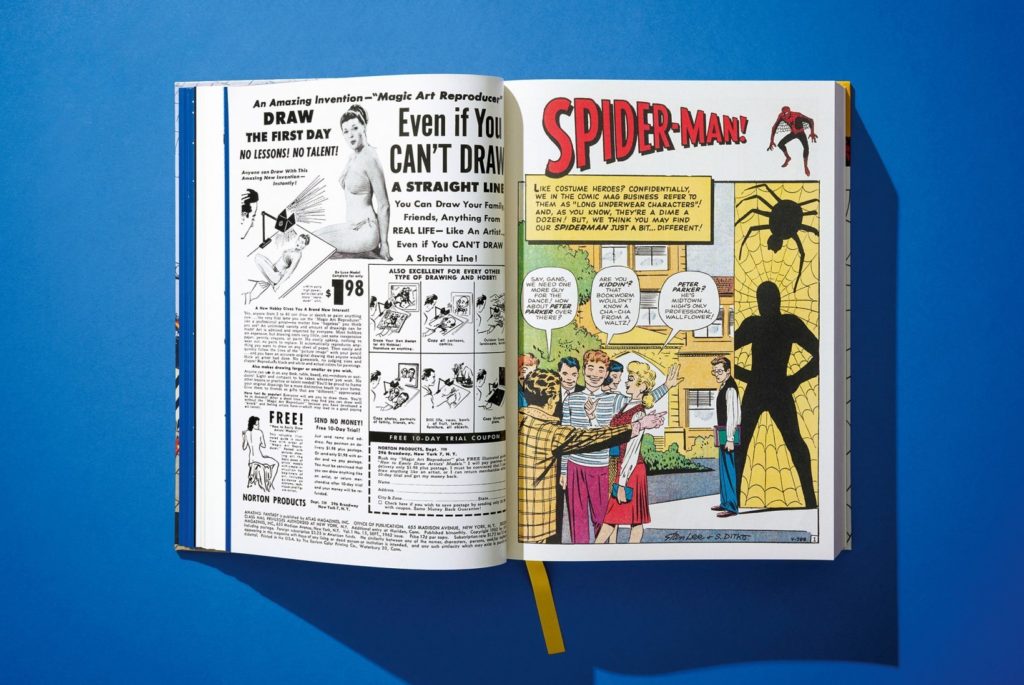
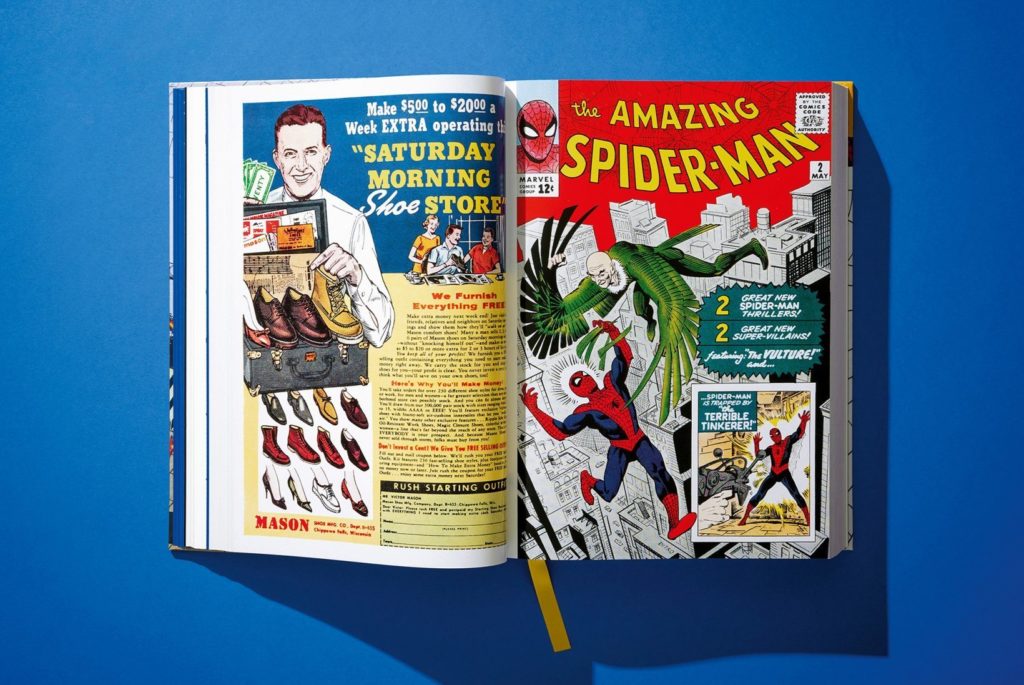
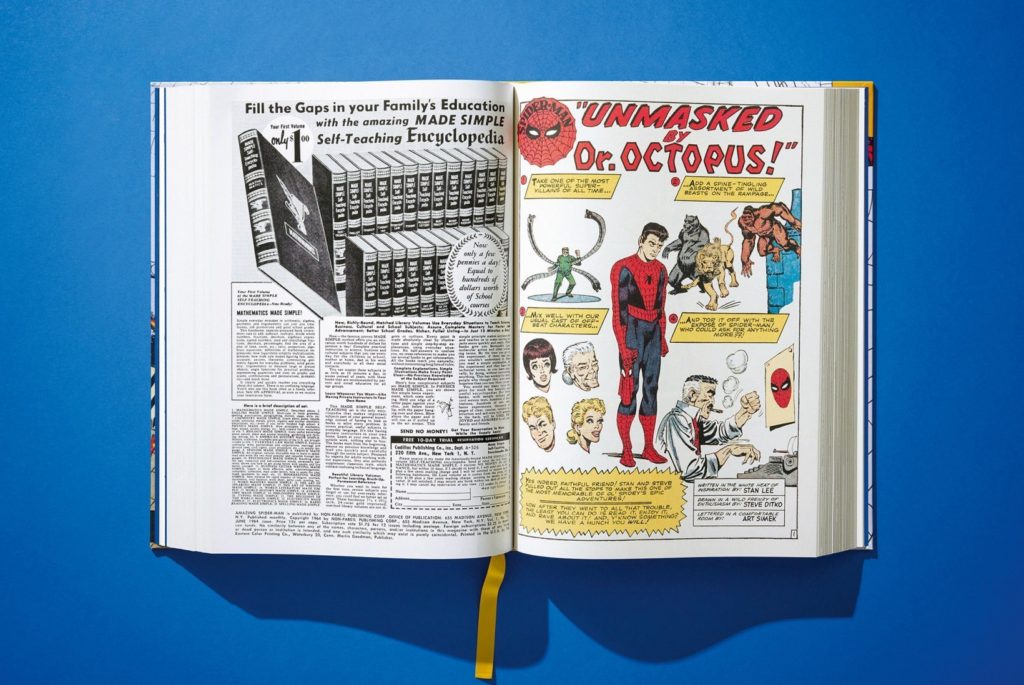
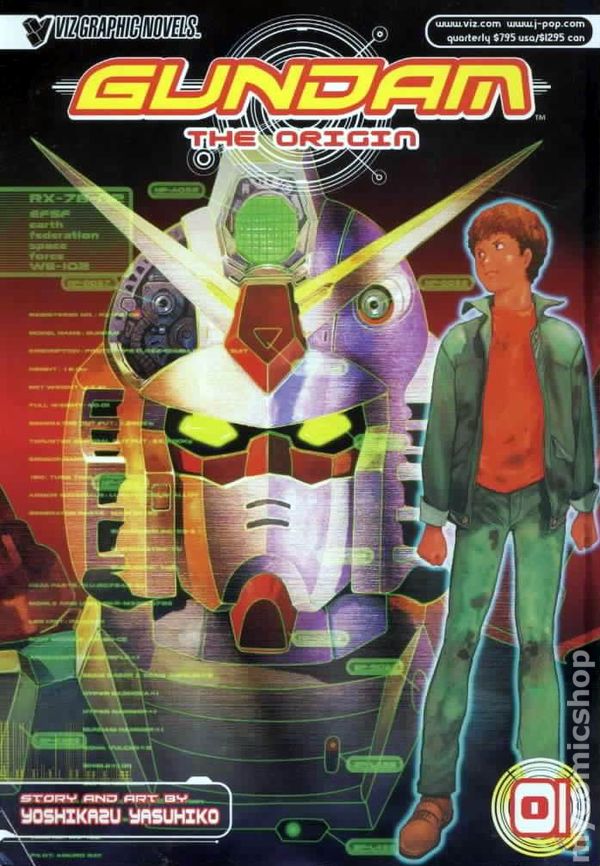
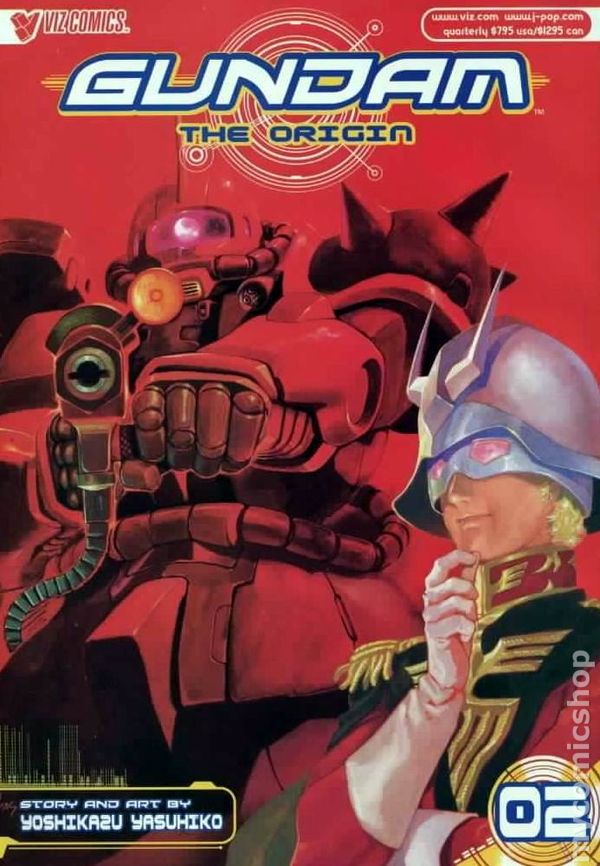
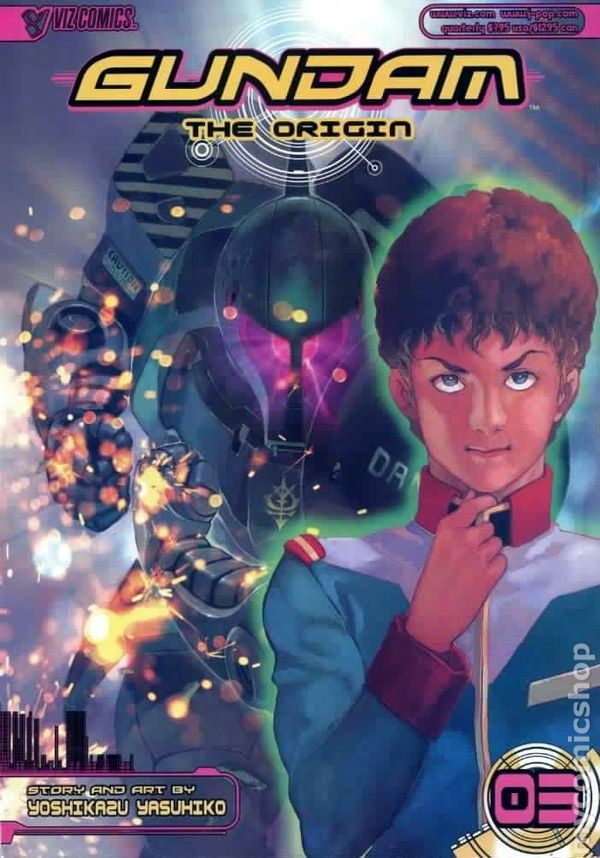
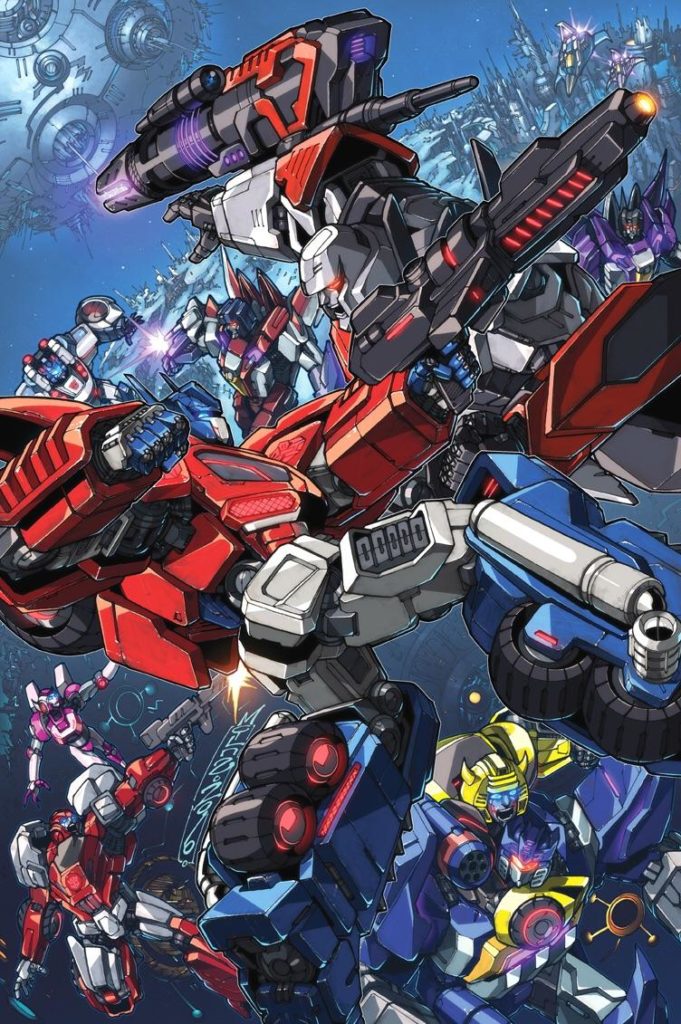
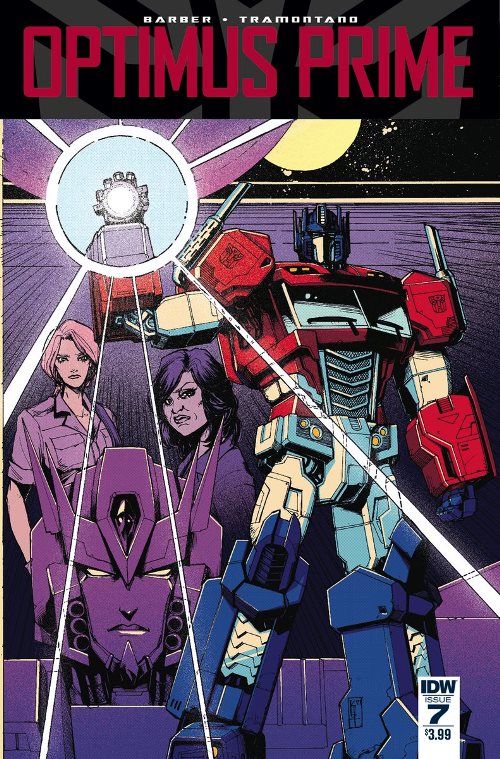
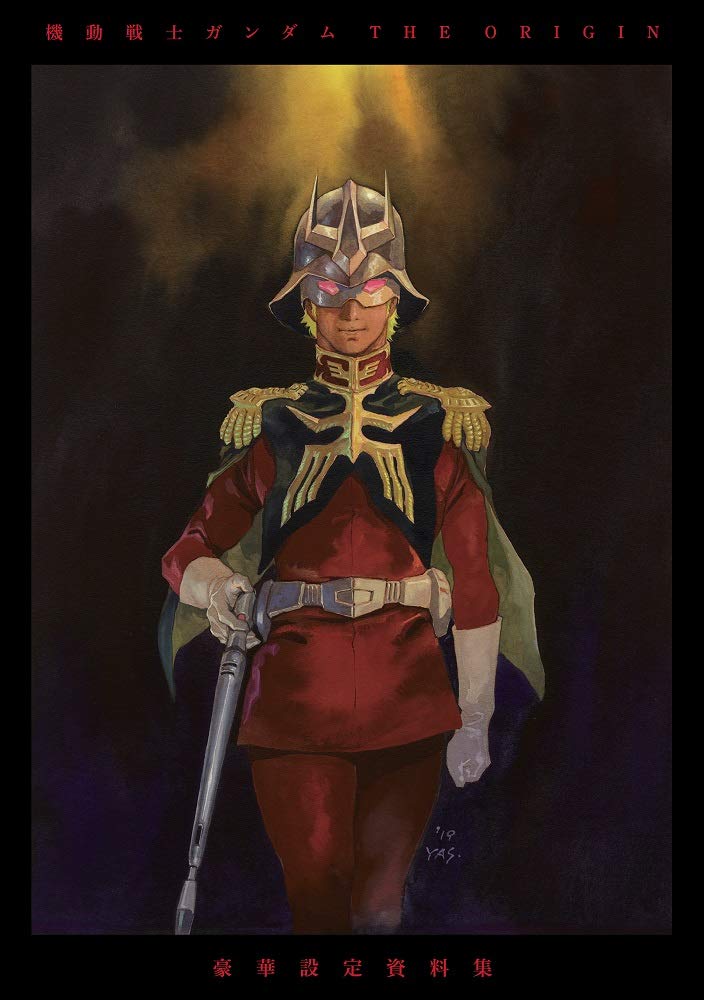
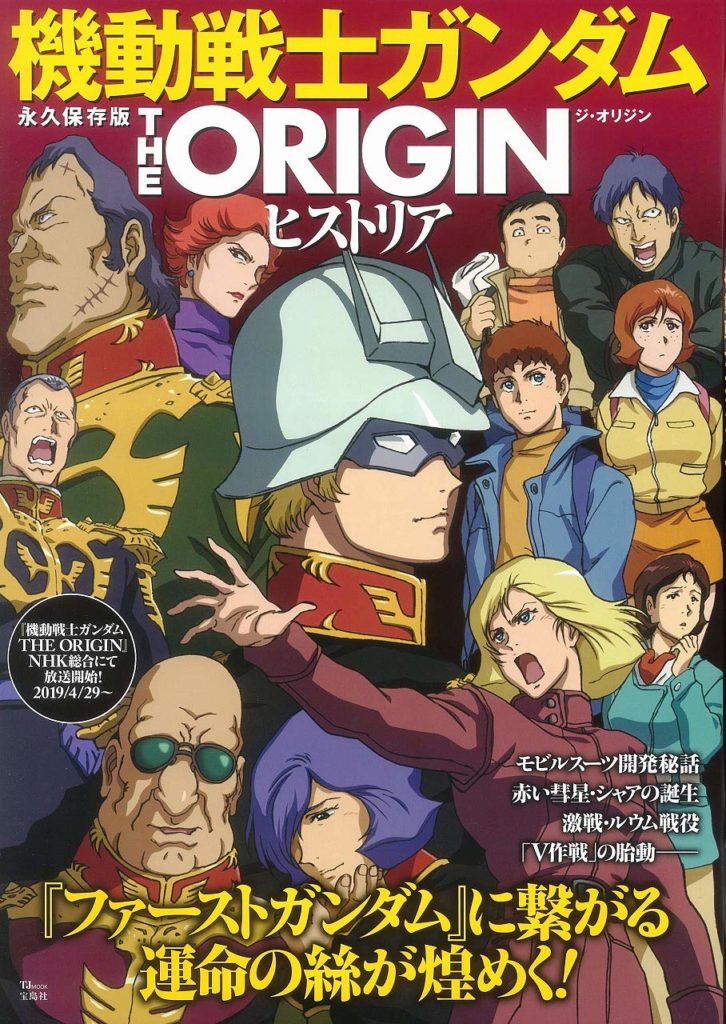
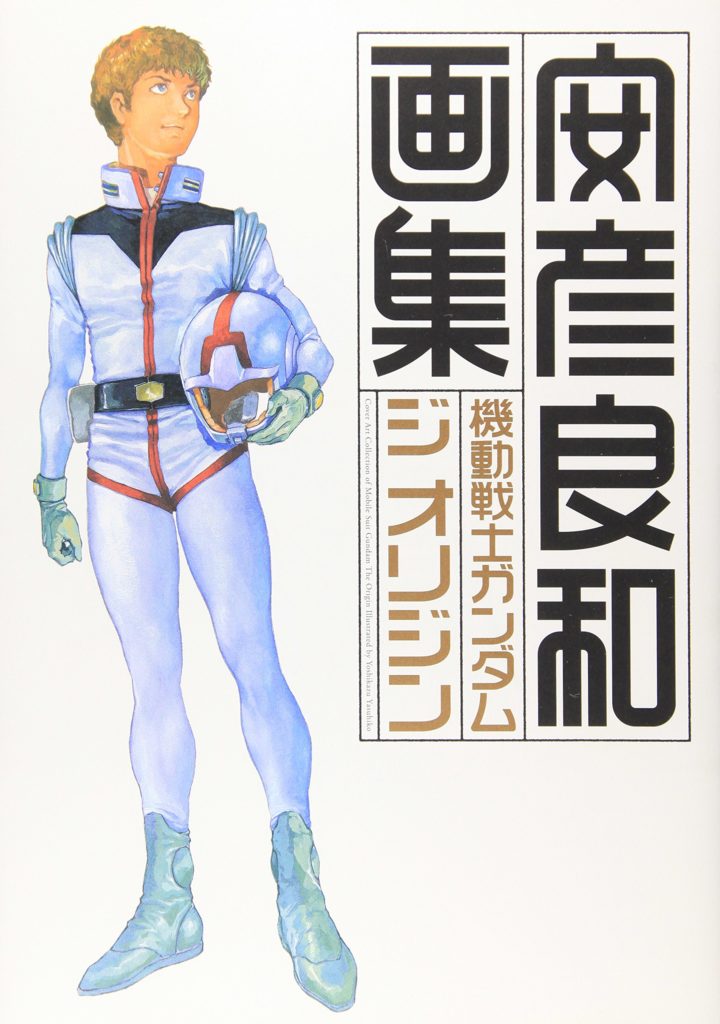
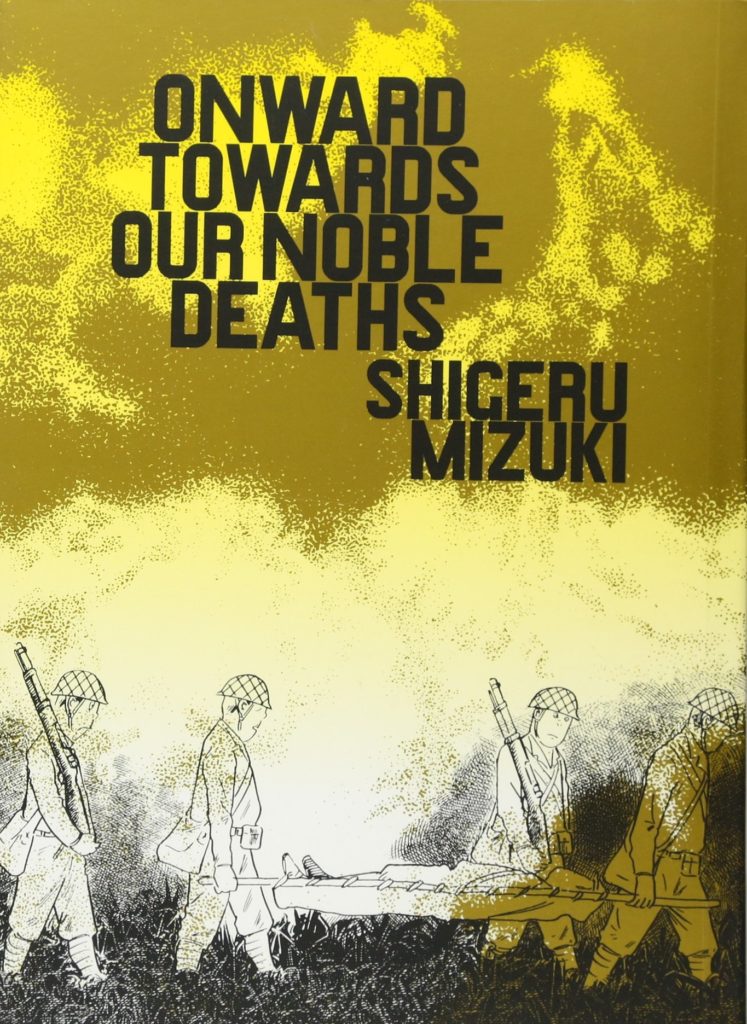
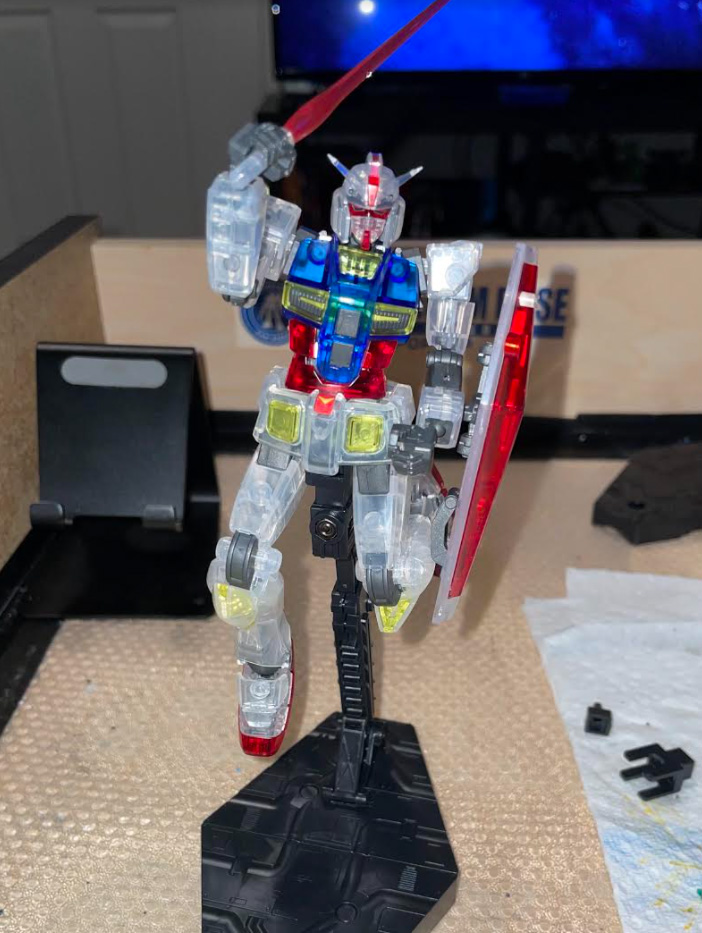
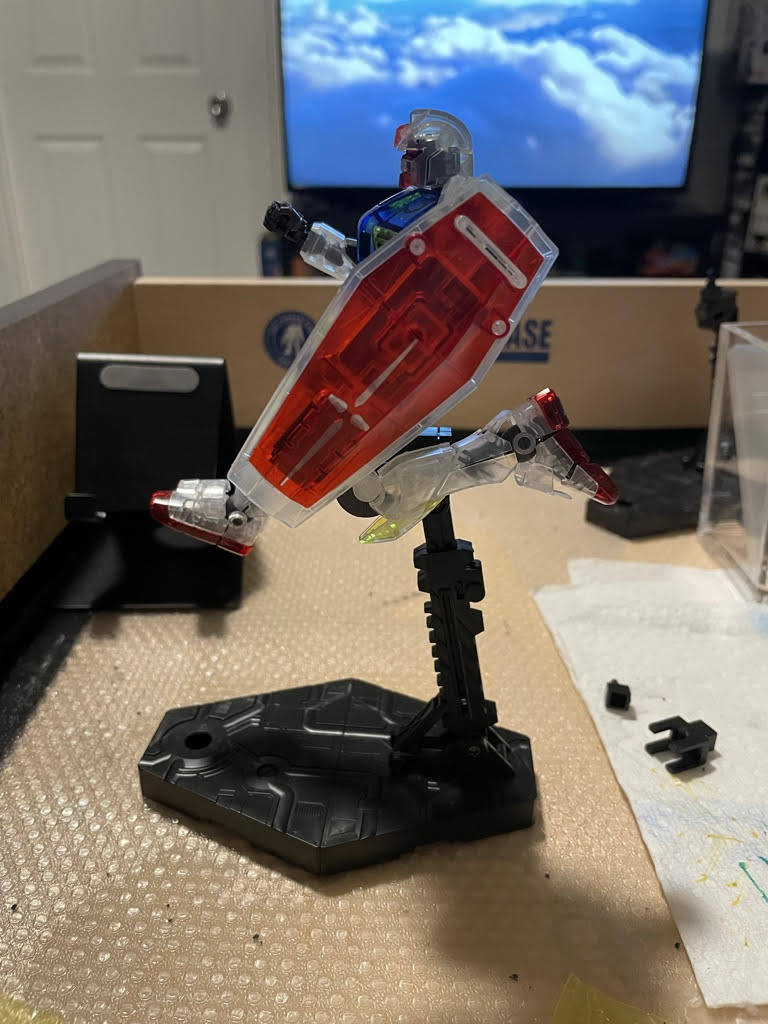
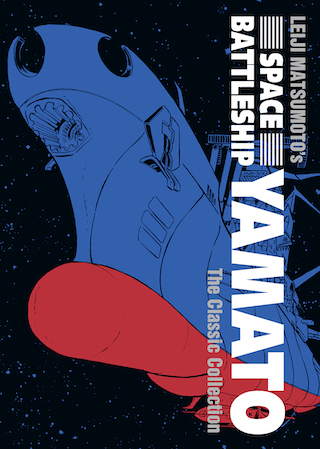
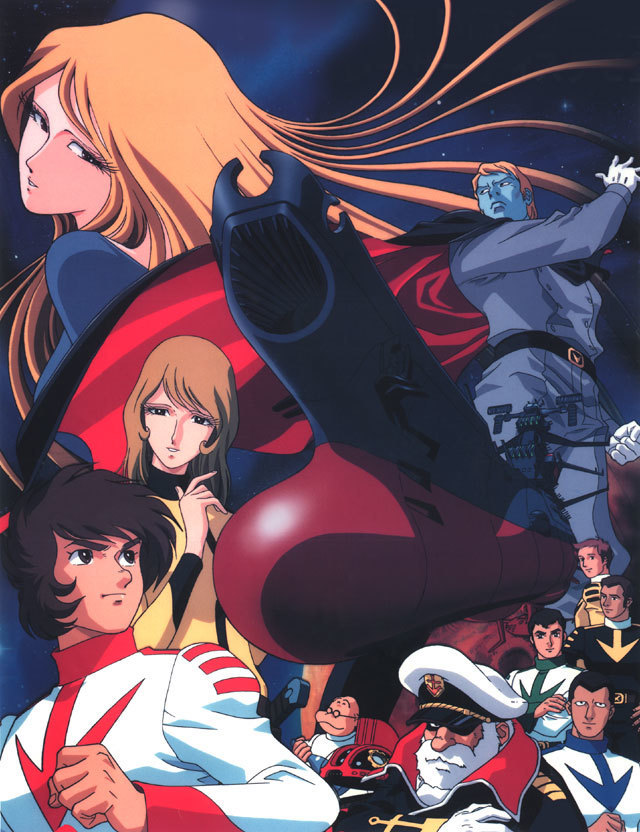

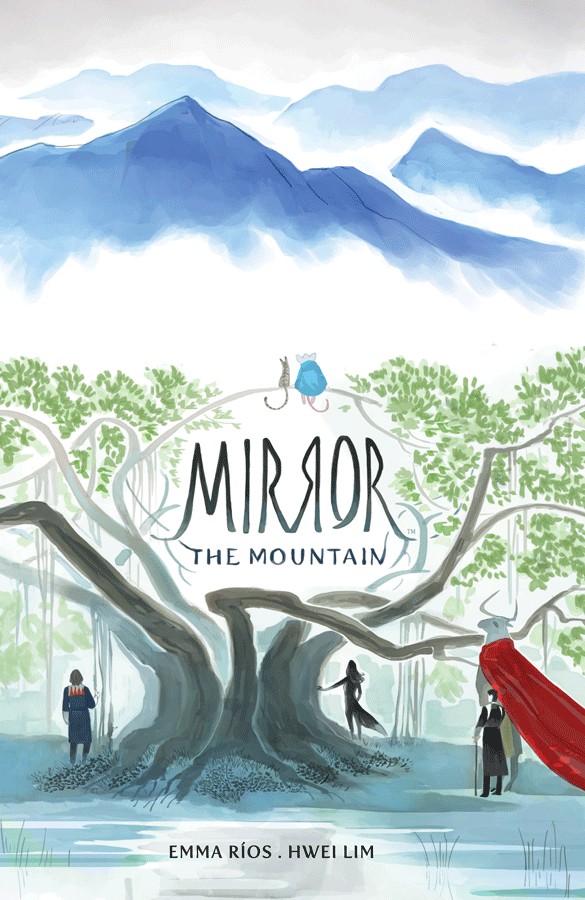
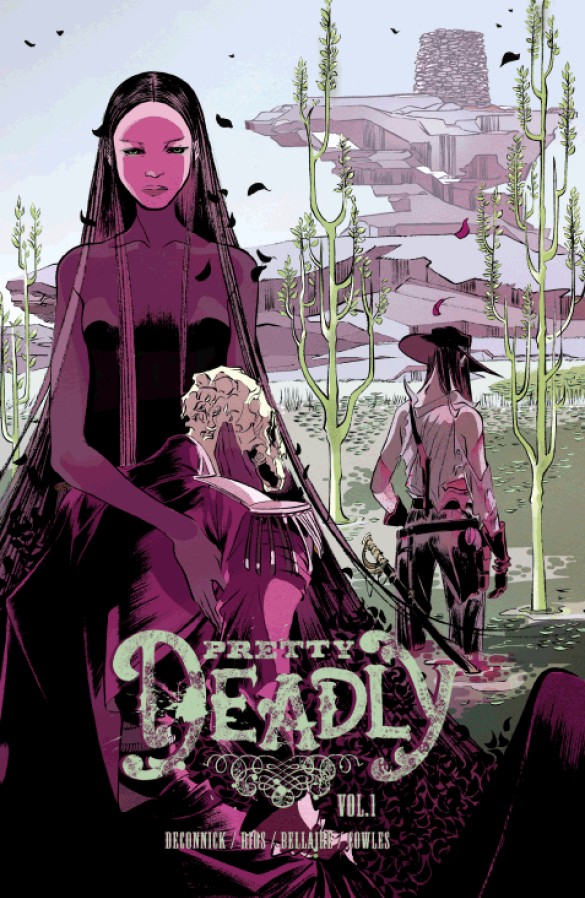

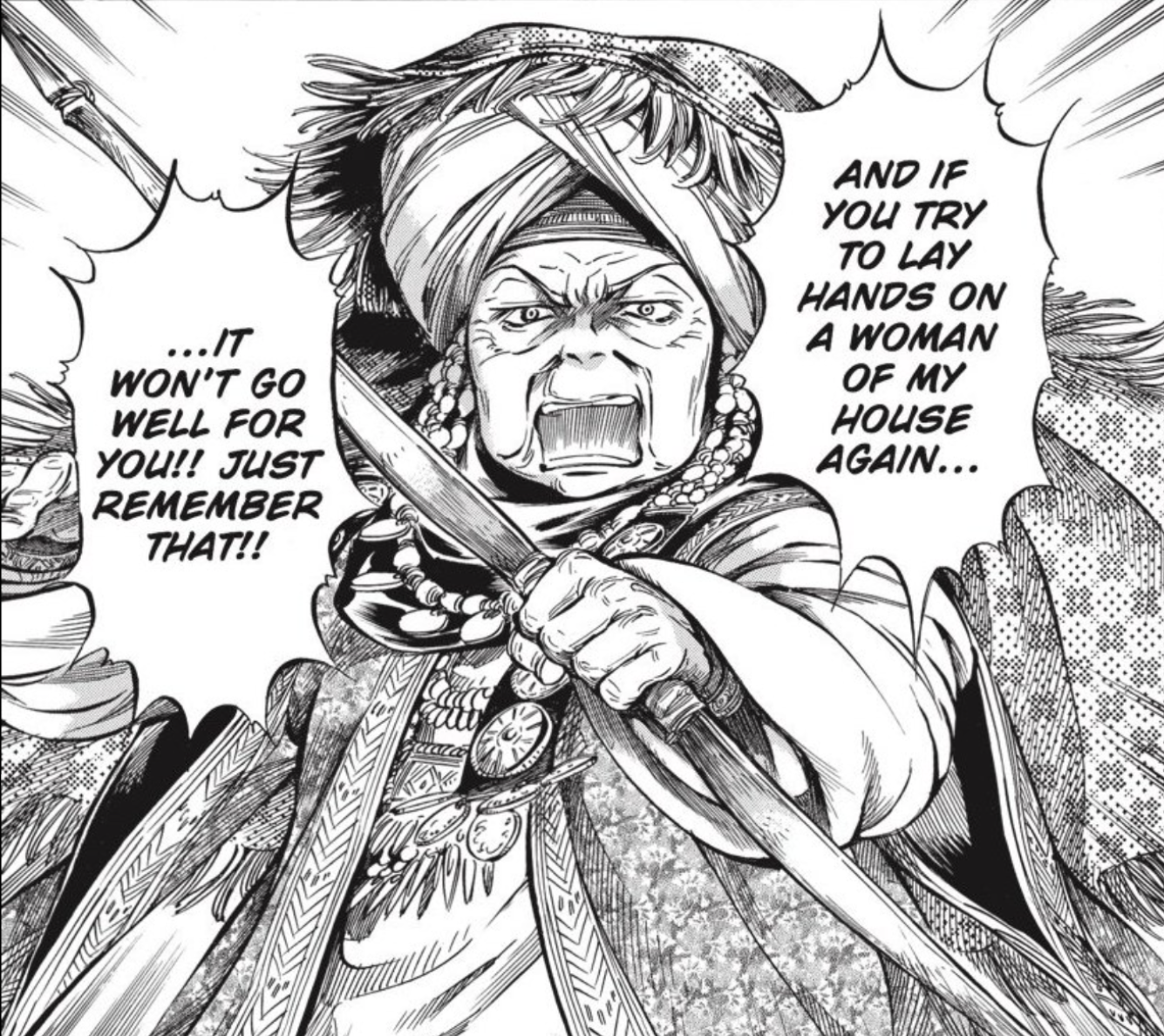
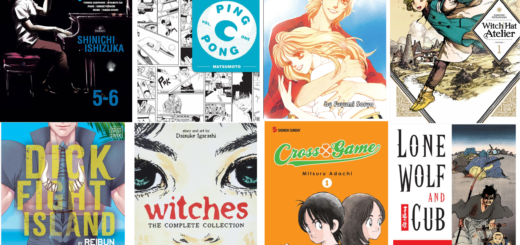
If you ever want to add another series about war, I recommend In this Corner of the World.
It’s a favourite! Thanks for the recommendation!
Some notes on Gundam: The Origin’s manga releases!
– I am pretty sure the first place I read Gundam: The Origin was actually in Newtype USA?? I want to say that for a while, that weird American version of Newtype publised by ADV printed exerpts of the first couple of chapters monthly as an insert! Wild stuff- also, the art looked great because it was printed gigantic in the magazine.
– I thiiiiink that’s how I first read it, because I remember my familiarity with the comic’s quality being the reason I bought the first volume at a Book Off in Japan on a trip in 2008.
– There are TWO major differences between the Japanese and American versions of Gundam the Origin: the Japanese version has a slip cover, and the Japanese version also has A BUILT IN BOOKMARK. They really gave it the deluxe treatment in Japan! :O
Nice! Thankis for the Info, David!
Amazingly extensive show notes! Thank you!
I watched Gundam Wing on Toonami when I was 13 and somehow my cousin found the whole series on DVD the next year and gave it to me for Christmas.
I was obsessed. With the Char clone Zechs being my favorite character. I was bummed when i found out it was only popular over here. But i tried to rewatch it recently after over a decade of not seeing it and it doesn’t hold up quite as well as it did to me in my teens.
I’ve read the first three volumes of origin and i bought all 12. I kind of regret that. I’m sure i’ll read all of them and enjoy it. I just don’t think this will be something i’m going to want to reread over and over.
Just to stick up for Gundam Wing’s reputation–it was very popular in Japan when it aired in 1995 (I think the N American version was 5 or so years later? Well after I had seen fansubs). It had its run extended, and they planned for a sequel, also having OVAs, etc, etc, and I remember how heavily it was covered in magazines at the time (it also, of course, was very popular in the yaoi doujinshi community). I think it’s only since then that it’s reputation in Japan, from all I’ve heard, hasn’t held up–and that’s mostly among hardcore anime/Gundam fans. But, relatively speaking, it was a big success in its original broadcast with a wide audience.
As a Dragonlance fan I’m here to defend it! (this is a joke)
Ok the first trilogy has a lot of LotR similarities but the second trilogy that focuses on the twins is so good and is what actually makes DL memorable and worth reading today.
The first three are like Next Generation season 1. You won’t enjoy it as much as the later stuff but you need to experience it to get the foundation.
Also, W&H are releasing a new DL novel in 2022 for the first time in YEARS!
Haha! No defense necessary. 🙂
I know i’m being super picky here but if Deb could just give a little pause break between saying One Piece and whatever point about the show she is bringing up i would be grateful.
I’m currently on chapter 800 and taking breaks after each major arc and i don’t always get to the skip button fast enough when i hear her say “one piece”
Fair point! We will all try to be better about spoilers in future.
If folks want to watch one emotionally gripping Gundom, I definitely recommend 0079 War in the Pocket, which is from the civilian side and deeply emotionally compelling.
Fabulous note here, folks – that’s a lot of work, thank you.
Thanks so much, Erica!
Been waiting eagerly for this episode, seeing as how this Christmas I just completed my MSG:TO collection (currently on volume 10).
Part of me really just wants to gush about Gundam here in the comments, and particularly about how good of job YAZ did with his revisions to the story and lore, even minor inconsequential things like the redesigns and new development history for the Guncannon and Guntank.
The Origin is an excellent remake, and is part of the reason that I don’t groan every time something like it gets announced. The benefit of 20 years of hindsight, as well as a critical eye can be a hell of a boost to a story.
I think we all agree with that,even if we don’t have the historical grounding in Gundam. Thanks so much for your comment!
Another fantastic episode. Like some of the panel, I’ve always wanted to learn more about Gundam as a franchise, though personally it’s simply not the kind of anime/manga that really connects with me (I woulda loved it as a kid in the 80s, I’m sure). I’m a cliche–the only Giant Robo series I found (at least originally) compelling is Evangelion… well, except that’s a lie–one of the first fansub series I watched completely as a teen in the 90s before it came to TV here was Gundam Wing–but yes, what appealed to me so much about that series were probably all the things many Gundam fans hated about it–the hot moody bishonens, etc–in fact I loved the moodiness in general but but found the battles boring.
Anyway–I’m intrigued to check out a bit more now…
Side note, Yoshikazu Yasuhiko has had a fascinating career–I’m sure many anime fans my age grew up with the early release of his Venus Wars (and now we have the beautifully animated and scored–Hisaishi!–Arion as well) but he *also* directed the OVA adaptation of Keiko Takemiya’s Kaze to Ki No Uta, so pretty hardcore BL stuff wasn’t outside of his wheelbarrow. (You knew I’d have to bring up a Year 24 mangaka).
GoComics were kinda amazing even if the only series I collected faithfully from them (till they folded) was their translation of the shoujo horror 70s classic Bride of Deimos. I also did get their early, sadly digital only (and in terrible quality) two volumes of josei (!) manga by Hatsu Akiko, a josei pioneer who started off as a Moto Hagio assistant, as well, back when I think the only josei titles we had had were the Keiko Nishi titles from Rachel Thorn/Viz.
It’s funny, like @hermanos I spent forever being sort of “aware” of Gundam, but 2021 was the year I finally got “into” Gundam. Confluence of events – I finally watched some classic sci-fi anime – Yamato, Gunbuster, Evangelion – and then was at a B&N and noticed an entry grade kit on sale for literally $8 and said, hey why not.
I then watched the entirety of original series (i just can’t do abridged movies if I know there’s a more complete version of the story), and thought that while it was very dated, it was also very impressive, and the DNA of so much great stuff like Macross and Evangelion was so apparent. I’ve now watched the sequel Zeta, and watching ZZ (what a whiplash in tone) and have done some additional kits.
I also picked up the first Origin book, which yeah, this book is gorgeous. Though I agree with Chip that the color pages are vastly superior and far more comprehensible.
Been a real commitment, but also very rewarding in terms of pop cultural understanding and pure entertainment. Planning to keep going. Curious what other series might be worth a watch.
If you’ve enjoyed the original series and Zeta, I’d recommend the other works set in the U.C. timeline, specifically 0080: War in the Pocket, 0083: Stardust Memory, The 08th MS Team, and Char’s Counterattack. The first three are OVAs that are standalone stories that work as their own unique entities. Char’s Counterattack is the 1988 movie classic that will give you an ending to the story that began with the original series.
If you end up watching all of those and still can’t get enough, then you should check out Mobile Suit Gundam Unicorn, one of the relatively recent productions. (If you can, try to watch the original feature length OVAs, and not the re-edited TV series.) Unicorn is a series that’s definitely made by U.C. fans for U.C. fans.
There’s also an anime adaptation of The Origin directed by Yas himself – but it’s not really a remake of the original series. Instead, it adapts a couple of specific arcs from the manga that weren’t in the old show. I enjoyed it, but I think I’d still have to say I like the comic more.
Really enjoyed this episode, as I’ve always wanted to pick this series up, so now I’m definitely going to pick it up.
I’m also glad you mentioned Joan! I got all three volumes in a clearance bin at AWA in the mid-2000s, and they’re just gorgeous editions – all in color with heavy paperstock.
First, thank you for these amazing show notes! I think it took me over a half hour just to get through them, and that’s excluding time spent clicking through the links.
Second, I’m glad you finally forced me to read some Gundam. I bought the first volume of Origin second hand for cheap, mainly because I can’t resist a hardcover comic with a ribbon bookmark and a dust jacket, but also because this particular series comes up often enough in conversations that it seemed worth checking out. I’ve never really been interested in Gundam, but learned enough of it from osmosis by dint of living in Japan. I think everything you said nails its status. It’s simultaneously ubiquitous and yet not popular. Everyone knows it, but not everyone has seen it. Yet its pervasiveness in the culture remains unrivaled. Maybe pre-Disney-owned Star Wars is the best example. Anyway, that’s just preamble to say I LOVED this book and I am definitely going to read more. Everything you all said in praise of it I agree with wholeheartedly. Can’t believe I’ve been denying myself thi for so long!
I watched some of the OVAs when I was kid in the ’90s, and my brother even had some of the U.S.-made novels. I think we were attracted to it because of our love for Transformers, Voltron, and other Japanese robots. For some reason or another Gundam just didn’t stick with us. But let me tell you, working for a games company with a lot of middle-aged Japanese people who grew up on Gundam, they never miss an opportunity to make a reference to it. They’ll even use character/place/mobile suit names as adjectives or other descriptors in scripts and design documents, and I’ll just be like, “What the heck does this mean?” It’s used as a shorthand to convey information, and that is interesting in the abstract, but can be frustrating to deal with. I remember one game where I told the lead designer that the prologue was just not working, and we needed to rewrite the script. He said he was aiming for a homage to the opening of Gundam where an entire space colony gets dropped on Earth. Once he explained that, I was able to figure a way to adjust the script so it was awkward but still achieved what he was looking for.
I always wondered why they use mobile suits instead of tanks or X-Wings or what have you, and it was explained to me that the technology that makes the MSs possible also negates radar. A quick search bears that out, but I was surprised it was exactly made clear in this first volume. I think that’s always why I resisted Gundam–I couldn’t understand why they need to use MSs.
And then, of course, Emma Rios has to go and say, “They never miss an opportunity to remind you there are people inside.” And that really clicked for me. It’s easy to overlook the human casualties of war when it’s tanks or ships blowing up; when it’s a vehicle that looks like a person, well, it’s not that much different from a person in full body armor, is it? That was such a good point. I really liked how the art in this volume was subtle but conveyed multitudes. There was just the slightest of convex or concave lines above the cyclopean eye of the Zakus to convey that the pilot was surprised, angry, or scared, a more nuanced version of making Spider-Man’s or Batman’s mask expressive.
One thing I am not a fan of with Gundam and Macross and Evangelion is having child pilots. I couldn’t even get my driver’s license until I was 17, and these are 14-year-olds piloting their world’s equivalent of an F-16? I know it’s the trope, but just one I’ve never personally cottoned to.
Going back to my co-workers, one of the big debates between my Japanese co-workers and my North American co-workers was which was better, Gundam or Transformers. I think the Japanese staff were a tad envious that Transformers were going through a renaissance thanks to the Michael Bay movies, but Gudam was not a that point in time. For them it came down to this: Gundam is cool because they’re awesome vehicles, whereas Transformers don’t really count because they’re just aliens who happen to look like robots. The debate was all in good fun over drinks (back when you could do things over drinks), but I thought it was an interesting perspective. I guess as a kid I found it more believable that I could befriend robotic beings from another planet then even be allowed to pilot a robot no matter how realistically designed it was.
Finally, the portrayal of war in Japanese and North American comics always feels different, with NA comics no matter how anti-war they are still coming off as surprisingly pro-war sometimes. Sorry, too tired to write more on it, but that topic could also be its own podcast.
Anway, great show and great show notes. Kudos to you for figuring out how to approach the topic of Gundam so succinctly. And thanks for bringing on Emma Rios for her perspective on Gundam.